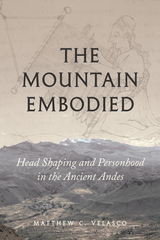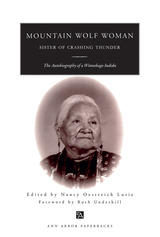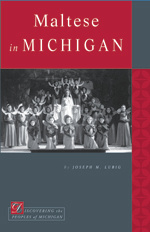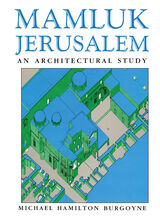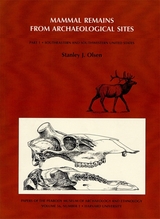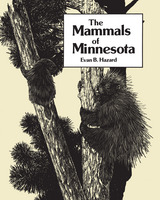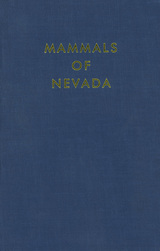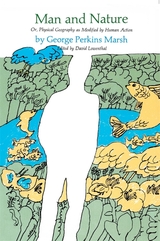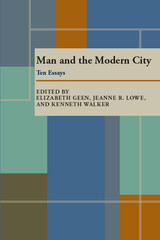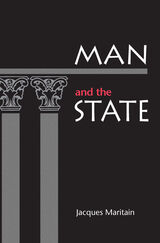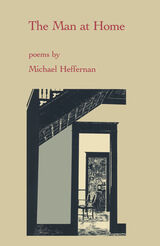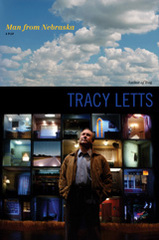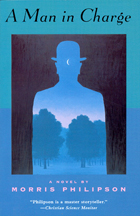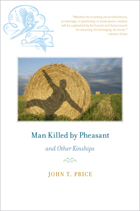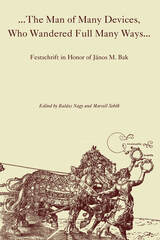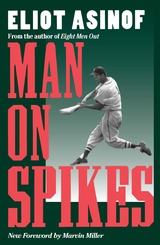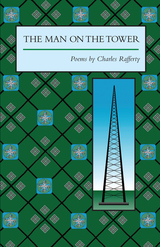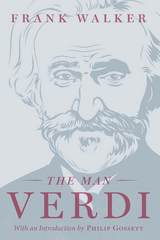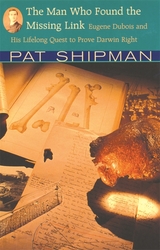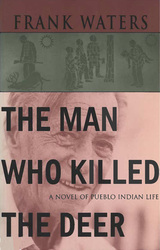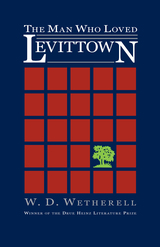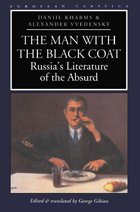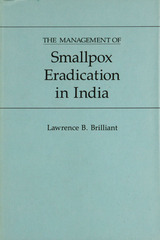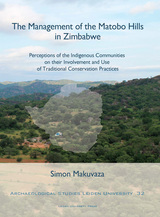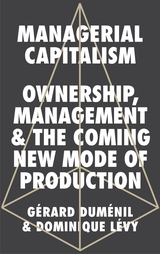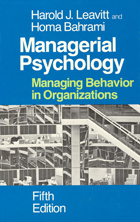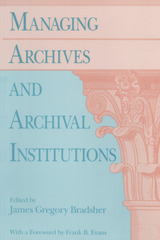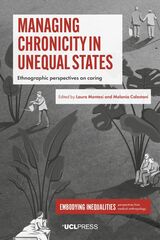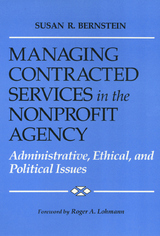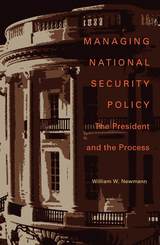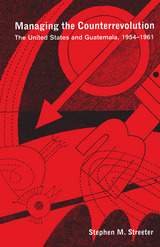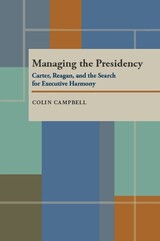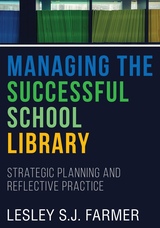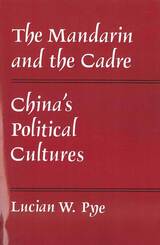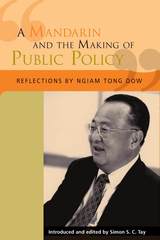Maltese in Michigan
Joseph M. Lubig
Michigan State University Press, 2011 Maltese in Michigan is an enlivening volume depicting the struggles and accomplishments of a singular culture, an immigrant narrative at once recognizable and enigmatic. Without realizing it, most Americans are probably familiar with the Maltese people through the cross displayed by firefighters, which bears a strong similarity in design and meaning to the one used by the Knights of Malta. The noble qualities embodied by the Maltese Cross are reflected in the pride and accomplishments of Maltese immigrants in Michigan, a small but vibrant ethnic group. Rooted in the post–World War II experiences of the 20th century, the Maltese established themselves in the city of Detroit, and thrived due to a strong work ethic and Catholic faith, while maintaining a strong central identity. This volume is a tribute to the Maltese of Michigan and all who have begun anew in an unfamiliar land and culture.
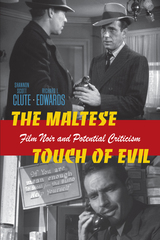 The Maltese Touch of Evil: Film Noir and Potential Criticism
Shannon Scott Clute and Richard L. Edwards
Dartmouth College Press, 2011 Noir is among the most popular, acclaimed, and critically assessed film styles of all time. The unfortunate consequence is an ever-growing divergence between fans and scholars with regard to goals and methods for appreciating and studying noir. The Maltese Touch of Evil aims to bridge that gap. Based on a series of popular podcasts, this unique and inspired investigation of film noir sets out to examine the case of noir more closely, and in the process reconfigures the critical evidence on noir that has been presented to date. The Maltese Touch of Evil reproduces and re-sequences nearly 150 still images from 31 great films, laying them out with the authors’ informed and entertaining insights into the significance of each shot. The result is a de facto meta–film noir, a celebration of the genre that shows how these films are themselves “constrained” texts whose carefully calculated visual forms simultaneously generate narrative and critical commentary on that narrative. You will never look at film noir the same way again.
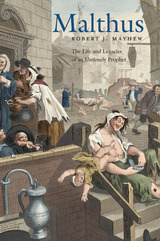 Malthus: The Life and Legacies of an Untimely Prophet
Robert J. Mayhew
Harvard University Press, 2014 Thomas Robert Malthus’s An Essay on the Principle of Population was an immediate succès de scandale when it appeared in 1798. Arguing that nature is niggardly and that societies, both human and animal, tend to overstep the limits of natural resources in “perpetual oscillation between happiness and misery,” he found himself attacked on all sides—by Romantic poets, utopian thinkers, and the religious establishment. Though Malthus has never disappeared, he has been perpetually misunderstood. This book is at once a major reassessment of Malthus’s ideas and an intellectual history of the origins of modern debates about demography, resources, and the environment.
Against the ferment of Enlightenment ideals about the perfectibility of mankind and the grim realities of life in the eighteenth century, Robert Mayhew explains the genesis of the Essay and Malthus’s preoccupation with birth and death rates. He traces Malthus’s collision course with the Lake poets, his important revisions to the Essay, and composition of his other great work, Principles of Political Economy. Mayhew suggests we see the author in his later writings as an environmental economist for his persistent concern with natural resources, land, and the conditions of their use. Mayhew then pursues Malthus’s many afterlives in the Victorian world and beyond.
Today, the Malthusian dilemma makes itself felt once again, as demography and climate change come together on the same environmental agenda. By opening a new door onto Malthus’s arguments and their transmission to the present day, Robert Mayhew gives historical depth to our current planetary concerns.
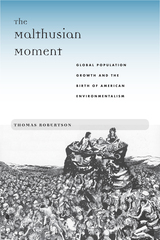 The Malthusian Moment: Global Population Growth and the Birth of American Environmentalism
Robertson, Thomas
Rutgers University Press, 2012 Although Rachel Carson’s Silent Spring (1962) is often cited as the founding text of the U.S. environmental movement, in The Malthusian Moment Thomas Robertson locates the origins of modern American environmentalism in twentieth-century adaptations of Thomas Malthus’s concerns about population growth. For many environmentalists, managing population growth became the key to unlocking the most intractable problems facing Americans after World War II—everything from war and the spread of communism overseas to poverty, race riots, and suburban sprawl at home. Weaving together the international and the domestic in creative new ways, The Malthusian Moment charts the explosion of Malthusian thinking in the United States from World War I to Earth Day 1970, then traces the just-as-surprising decline in concern beginning in the mid-1970s. In addition to offering an unconventional look at World War II and the Cold War through a balanced study of the environmental movement’s most contentious theory, the book sheds new light on some of the big stories of postwar American life: the rise of consumption, the growth of the federal government, urban and suburban problems, the civil rights and women’s movements, the role of scientists in a democracy, new attitudes about sex and sexuality, and the emergence of the “New Right.”
 Malvina, or Spoken Word in the Novel
Ewa Szary-Matywiecka
Karolinum Press, 2020 In this book-length study, Ewa Szary-Matywiecka examines Maria Wirtemberska’s Malvina, or the Heart’s Intuition, an international success upon its publication in 1816 that is now widely considered to be Poland’s first psychological novel. Applying structuralist methods, Szary-Matywiecka situates Wirtemberska among other literary luminaries of her day, including Rousseau and Goethe, and explores how the nineteenth-century salon culture formed the concerns and themes of her novel. Malvina’s obsession with language games recall the vocabulary quizzes and semantic puzzles popular in the European salons frequented by Wirtemberska. Szary-Matywiecka also argues that the novel’s motif of twins and twinned characters emerges from both the theatrical preoccupations of salons, as well as how Wirtemberska seemingly splits her voice between traditional narration and a more intrusive authorial style, helping shape her novel’s innovative narrative method. Malvina, or Spoken Word in the Novel is an insightful deconstruction of a female-penned classic of European literature.
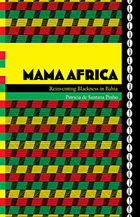 Mama Africa: Reinventing Blackness in Bahia
Patricia de Santana Pinho
Duke University Press, 2010 Often called the “most African” part of Brazil, the northeastern state of Bahia has the country’s largest Afro-descendant population and a black culture renowned for its vibrancy. In Mama Africa, Patricia de Santana Pinho examines the meanings of Africa in Bahian constructions of blackness. Combining insights from anthropology, sociology, and cultural studies, Pinho considers how Afro-Bahian cultural groups, known as blocos afro, conceive of Africanness, blackness, and themselves in relation to both. Mama Africa is a translated, updated, and expanded edition of an award-winning book published in Brazil in 2004. Central to the book, and to Bahian constructions of blackness, is what Pinho calls “the myth of Mama Africa,” the idea that Africa exists as a nurturing spirit inside every black person. Pinho explores how Bahian cultural production influences and is influenced by black diasporic cultures and the idealization of Africa—to the extent that Bahia draws African American tourists wanting to learn about their heritage. Analyzing the conceptions of blackness produced by the blocos afro, she describes how Africa is re-inscribed on the body through clothes, hairstyles, and jewelry; once demeaned, blackness is reclaimed as a source of beauty and pride. Turning to the body’s interior, Pinho explains that the myth of Mama Africa implies that black appearances have corresponding black essences. Musical and dance abilities are seen as naturally belonging to black people, and these traits are often believed to be transmitted by blood. Pinho argues that such essentialized ideas of blackness render black culture increasingly vulnerable to exploitation by the state and commercial interests. She contends that the myth of Mama Africa, while informing oppositional black identities, overlaps with a constraining notion of Bahianness promoted by the government and the tourist industry.
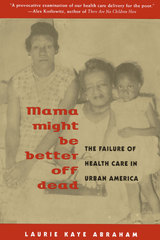 Mama Might Be Better Off Dead: The Failure of Health Care in Urban America
Laurie Kaye Abraham
University of Chicago Press, 1993 Mama Might Be Better Off Dead is an unsettling, profound look at the human face of health care. Both disturbing and illuminating, it immerses readers in the lives of four generations of a poor, African-American family beset with the devastating illnesses that are all too common in America's inner-cities.
The story takes place in North Lawndale, a neighborhood that lies in the shadows of Chicago's Loop. Although surrounded by some of the city's finest medical facilities, North Lawndale is one of the sickest, most medically underserved communities in the country. Headed by Jackie Banes, who oversees the care of a diabetic grandmother, a husband on kidney dialysis, an ailing father, and three children, the Banes family contends with countless medical crises. From visits to emergency rooms and dialysis units, to trials with home care, to struggles for Medicaid eligibility, Abraham chronicles their access (or lack of access) to medical care.
Told sympathetically but without sentimentality, their story reveals an inadequate health care system that is further undermined by the direct and indirect effects of poverty. When people are poor, they become sick easily. When people are sick, their families quickly become poorer.
Embedded in the family narrative is a lucid analysis of the gaps, inconsistencies, and inequalities the poor face when they seek health care. This book reveals what health care policies crafted in Washington, D. C. or state capitals look like when they hit the street. It shows how Medicaid and Medicare work and don't work, the Catch-22s of hospital financing in the inner city, the racial politics of organ transplants, the failure of childhood immunization programs, the vexed issues of individual responsibility and institutional paternalism. One observer puts it this way: "Show me the poor woman who finds a way to get everything she's entitled to in the system, and I'll show you a woman who could run General Motors."
Abraham deftly weaves these themes together to make a persuasive case for health care reform while unflinchingly presenting the complexities that will make true reform as difficult as it is necessary. Mama Might Be Better Off Dead is a book with the power to change the way health care is understood in America. For those seeking to learn what our current system of health care promises and what it delivers, it offers a place for the debate to begin.
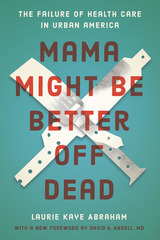 Mama Might Be Better Off Dead: The Failure of Health Care in Urban America
Laurie Kaye Abraham
University of Chicago Press, 1994 North Lawndale, a neighborhood that lies in the shadows of Chicago’s Loop, is surrounded by some of the city’s finest medical facilities, Yet, it is one of the sickest, most medically underserved communities in the country.
Mama Might Be Better Off Dead immerses readers in the lives of four generations of a poor, African-American family in the neighborhood, who are beset with the devastating illnesses that are all too common in America’s inner-cities. Headed by Jackie Banes, who oversees the care of a diabetic grandmother, a husband on kidney dialysis, an ailing father, and three children, the Banes family contends with countless medical crises. From visits to emergency rooms and dialysis units, to trials with home care, to struggles for Medicaid eligibility, Laurie Kaye Abraham chronicles their access—or more often, lack thereof—to medical care. Told sympathetically but without sentimentality, their story reveals an inadequate health care system that is further undermined by the direct and indirect effects of poverty.
Both disturbing and illuminating, Mama Might Be Better Off Dead is an unsettling, profound look at the human face of health care in America. Published to great acclaim in 1993, the book in this new edition includes an incisive foreword by David Ansell, a physician who worked at Mt. Sinai Hospital, where much of the Banes family’s narrative unfolds.
 Mama, PhD: Women Write about Motherhood and Academic Life
Evans, Elrena
Rutgers University Press, 2008 Every year, American universities publish glowing reports stating their commitment to diversity, often showing statistics of female hires as proof of success. Yet, although women make up increasing numbers of graduate students, graduate degree recipients, and even new hires, academic life remains overwhelming a man's world. The reality that the statistics fail to highlight is that the presence of women, specifically those with children, in the ranks of tenured faculty has not increased in a generation. Further, those women who do achieve tenure track placement tend to report slow advancement, income disparity, and lack of job satisfaction compared to their male colleagues.
Amid these disadvantages, what is a Mama, PhD to do? This literary anthology brings together a selection of deeply felt personal narratives by smart, interesting women who explore the continued inequality of the sexes in higher education and suggest changes that could make universities more family-friendly workplaces.
The contributors hail from a wide array of disciplines and bring with them a variety of perspectives, including those of single and adoptive parents. They address topics that range from the level of policy to practical day-to-day concerns, including caring for a child with special needs, breastfeeding on campus, negotiating viable maternity and family leave policies, job-sharing and telecommuting options, and fitting into desk/chair combinations while eight months pregnant.
Candid, provocative, and sometimes with a wry sense of humor, the thirty-five essays in this anthology speak to and offer support for any woman attempting to combine work and family, as well as anyone who is interested in improving the university's ability to live up to its reputation to be among the most progressive of American institutions.
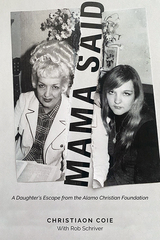 Mama Said: A Daughter’s Escape from the Alamo Christian Foundation
Christhiaon Coie
University of Tennessee Press, 2022 There are many books on the cult phenomenon that bloomed in the wake of the social upheaval of the 1960s, and many discuss the abuses of cult leaders; the physical, mental, and emotional challenges of breaking free; and the lived experiences of those who manage to leave and begin to heal. With Mama Said: A Daughter’s Escape from the Alamo Christian Foundation, we get a unique angle—what the daughter of a cult leader could see from the inside.
Christhiaon Coie grew up “Little Susie,” the daughter of Susan Alamo and stepdaughter of Tony Alamo, founders of the Alamo Christian Foundation. Coie continued to embrace the faith as she got older, but she was not a little girl anymore and began to realize that people don’t go to church and leave with the offering. She did not embrace the “faith” her mother was peddling, and she saw the financial grift that exploited the vulnerable followers. This is a story about the complex, unremitting relationship between a daughter and her abusive mother. Coie shares insight into Susan Alamo before her foundation days and reveals what it was like to grow up as her daughter between the 1950s and early 1970s. Across thirty-six chapters, she chronicles life within the Alamo cult and the twisted mother-daughter dynamic that persisted through it all. As Coie’s story unfolds, we see Little Susie transform into Christhiaon, navigating a manipulative mother and the distorted biblical teachings enlisted to her cause.
With a foreword from noted Alamo cult historian Debby Schriver, Coie’s gritty memoir is a true survivor story. What she survived, however, was not the cult only but the cruel double bind of what “mama said.”
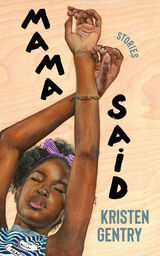 Mama Said: Stories
Kristen Gentry
West Virginia University Press, 2023 “A celebration of Black family life that will make you laugh and cry in equal measure.” —Kirkus Reviews (starred review)
“The collection will reshape what you think about the region and the people that inhabit it.” —Debutiful
“Surprising and revelatory. . . . I love this book.” —Stephanie Powell Watts, author of No One Is Coming to Save Us
“This book has staying power.” —Crystal Wilkinson, author of Praisesong for the Kitchen Ghosts
Original stories of Black family life in Louisville, Kentucky, for readers of Dantiel Moniz (Milk Blood Heat) and Kai Harris (What the Fireflies Knew).
The linked stories in Mama Said are set in Louisville, Kentucky, a city with a rich history steeped in tobacco, bourbon, and gambling, indulgences that can quickly become gripping and destructive vices. Set amid the tail end of the crack epidemic and the rise of the opioid crisis, Mama Said evokes Black family life in all its complexity, following JayLynn, along with her cousins Zaria and Angel, as they come of age struggling against their mothers’ drug addictions. JayLynn heads to college intent on gaining distance from her depressed mother, only to learn that her mother’s illness has reached a terrifying peak. She fears the chaos and instability of her extended family will prove too much for her boyfriend, whose idyllic family feels worlds, not miles, apart from her own. When bats invade Zaria’s new home, she is forced to determine how much she is willing to sacrifice to be a good mother. Angel rebels on Derby night, risking her safety to connect with her absent mother and the wild ways that consumed her. Mama Said separates from stereotypes of Black families, presenting instead the joy, humor, and love that coexist with the trauma of drug abuse within communities. Kristen Gentry’s stories showcase the wide-reaching repercussions of addiction and the ties that forever bind daughters to their mothers, flaws and all.
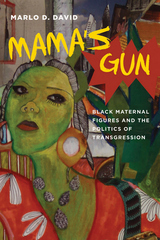 Mama's Gun: Black Maternal Figures and the Politics of Transgression
Marlo D. David
Ohio State University Press, 2016 In Mama’s Gun: Black Maternal Figures and the Politics of Transgression, Marlo D. David identifies five bold, new archetypes of black motherhood for the post-civil rights generation in order to imagine new ways of thinking about pervasive maternal stereotypes of black women. Rather than avoiding “negative” images of black motherhood, such as welfare queens, teen mothers, and “baby mamas,” Mama’s Gun centralizes these dispossessed figures and renames them as the Young Mother, the Blues Mama, the Surrogate, Big Mama, and the Mothership.
Taking inspiration from African American fiction, historical accounts of black life, Afrofuturism, and black popular culture in music and on screen, David turns her attention to Sapphire’s Push, Octavia Butler’s Dawn, and Suzan-Lori Parks’s Getting Mother’s Body as well as the performance art of Erykah Badu and the films of Tyler Perry. She draws out the implications of black maternal figures in these texts who balk at tradition and are far from “ideal.” David’s study shows how representations of blackness are deeply embedded in the neoliberal language of contemporary American politics and how black writers and performers resist such mainstream ideologies with their own transgressive black maternal figures.
Mamluk Jerusalem: An Architectural Study
Michael Hamilton Burgoyne
Council for British Research in the Levant, 1987 A survey of Mamluk architecture in the Old City of Jerusalem carried out by the British School of Archaeology in Jerusalem (BSAJ), beginning in 1968. It is authored by Michael. Hamilton Burgoyne, with additional historical research by D.S. Richards and published on behalf of the BSAJ by the World of Islam Festival Trust.
Mammal Remains from Archaeological Sites: Southeastern and Southwestern United States
Stanley J. Olsen
Harvard University Press This classic work provides a guide to the identification of nonhuman animal bones. Olsen illustrates various diagnostic characteristics of rodents and dogs; jaguars and other members of the cat family; the domestic horse, pig, and goat; and other animals whose bones are commonly found in archaeological sites in the southeastern United States.
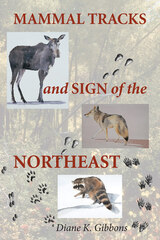 Mammal Tracks and Sign of the Northeast
Diane K. Gibbons
University Press of New England, 2003 Mammal Tracks and Sign of the Northeast is a field guide for identifying the tracks of mammal species native to the region which extends from New England, New York, and Pennsylvania to eastern Canada. Simple to use and light and easy to carry in the field, the book contains the most important information that a tracker will need—including life-size illustrations of tracks and scat, gait patterns, trail width, species habitat, food sources, scat and urine information, breeding seasons, range maps, and special tracking tips for all thirty-seven species. A unique dichotomous key devised by the author allows trackers to identify even the most confusing track through a process of elimination. The charming, highly detailed, and to-scale pencil illustrations are indispensable aids to accurate identification. Mammal Tracks and Sign of the Northeast is an artistic and accurately rendered guide suitable for professional trackers, naturalists and wildlife professionals, outdoor educators, hunters, and amateurs alike.
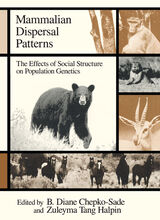 Mammalian Dispersal Patterns: The Effects of Social Structure on Population Genetics
Edited by B. Diane Chepko-Sade and Zuleyma Tang Halpin
University of Chicago Press, 1987 Mammalian Dispersal Patterns examines the ways that social structure affects population genetics and, in turn, rates of evolution, in mammalian groups. It brings together fieldwork in animal behavior and wildlife biology with theoretical work in demography and population genetics. The focus here is dispersal—whether, how, and when individuals leave the areas where they are born.
Theoretical work in population genetics indicates that such social factors as skewed sex ratios, restrictive mating patterns, and delayed age of first reproduction will lower the reproductive variability of a population by reducing the number of genotypes passed from one generation to the next. Field studies have shown that many mammalian species do exhibit many such social characteristics. Among horses, elephant seals, and a number of primates, the majority of females are inseminated by only a fraction of the males. In pacts of wolves and mongooses, usually only the highest-ranking male and female breed in a given season. Although socially restricted mating tends to lower genetic variability in isolated populations, it actually tends to increase genetic variability in subdivided populations with low rates of migration between subunits. Among some species there is little dispersal and thus little gene flow between subpopulations; other species travel far afield before mating.
The contributors to this volume examine actual data from populations of mammals, the way patterns of dispersal correlate with the genetic structure of individuals and populations, and mathematical models of population structure. This interdisciplinary approach has an important bearing on work in conservation of both wildlife and zoo populations, for it shows that the home range and the population size needed to maintain genetic variability can differ greatly from one species to the next. The volume also offers a fruitful model for future research.
 Mammalian Reproductive Biology
F. H. Bronson
University of Chicago Press, 1990 A unique interdisciplinary overview of the way mammals reproduce, this volume synthesizes research done by laboratory physiologists, behaviorists, population ecologists, and animal breeders. F. H. Bronson has drawn together the disparate literature in these areas to provide students and researchers with a comprehensive and biologically integrated approach to the study of mammalian reproduction.
Each chapter presents a wealth of issues and questions, summarizing the current consensus on interpretations as well as viable alternatives under debate. The book is principally concerned with how environmental factors regulate reproduction. Bronson proposes that a mammal's reproductive performance routinely reflects simultaneous regulation by several environmental factors that interact in fascinatingly complex ways. Environment is defined broadly, and the chapters give equal weight to ecological and physiological factors when considering how variables such as food availability, ambient temperature, photoperiod, and social cues interact to regulate a mammal's reproduction. Particular attention is given to seasonal breeding, and a taxonomically arranged chapter underscores the importance of comparative and evolutionary biology to an understanding of mammalian reproduction.
Mammalian Reproductive Biology is a powerful argument for the value and importance of interdisciplinary approaches to research. Its almost 1,500 references constitute the most comprehensive bibliography to date on this topic. Bronson also gives detailed consideration to promising areas for future research. Well organized, carefully planned, and clearly written, this book will become standard reading for scientists concerned with any aspect of mammalian biology.
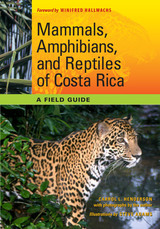 Mammals, Amphibians, and Reptiles of Costa Rica: A Field Guide
By Carrol L. Henderson
University of Texas Press, 2010 To help visitors, as well as local residents, identify and enjoy the wildlife of Costa Rica, Carrol L. Henderson published Field Guide to the Wildlife of Costa Rica in 2002, and it instantly became the indispensable guide. Now Henderson has created a field guide dedicated to the monkeys, sloths, treefrogs, lizards, crocodiles, and other animals that travelers are most likely to see while exploring the wild lands of Costa Rica. He includes fascinating information on their natural history, ecology, identification, and behavior gleaned from his forty years of travels, studies, and wildlife viewing in Costa Rica, as well as details on where to see these remarkable and beautiful creatures. The mammals, amphibians, and reptiles are illustrated by stunning and colorful photographs—most of which were taken in the wild by Henderson. A detailed and invaluable appendix that identifies many of Costa Rica's best wildlife-watching destinations, lodges, and contact information for trip-planning purposes completes the volume.
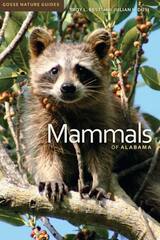 Mammals of Alabama
Troy L. Best and Julian L. Dusi
University of Alabama Press, 2014 Beautifully designed and sturdily bound for rugged field use, Mammals of Alabama is the first and only exhaustive guidebook to Alabama’s diverse and fascinating mammalian fauna.
European and American naturalists visited the territory that would become Alabama as early as the late eighteenth century and marveled at the breadth and variety of its flora and fauna. Yet until today scientists, scholars, and nature enthusiasts had no systematic guide to the state’s mammals. Mammals of Alabama fills the gap.
Naturally occurring in the state are nine orders, twenty-two families, fifty-one genera, and seventy-two species of living mammals. Best and Dusi offer an engaging entry for each as well as additional species that have become extinct through natural processes or human extirpation.
Illustrated with maps and photos, each entry includes:
• Identification notes • Dental formula
• Size and weight • Distribution
• Ecology • Life History
• Behavior • Parasites and Diseases
• Conservation Status • Notes and References
Ideal for backyards, hikes, libraries, and classrooms, Mammals of Alabama includes hundreds of professional, close-up color specimen photographs of both living animals in their natural habitats and skull plates, making identification of animals easy.
Best also offers fascinating and fun facts about Alabama mammals that will delight nature lovers of all ages, such as the surprising and excellent tree-climbing skills of the gray fox, the use in the past of mole skins to apply cosmetics, and the litters of identical quadruplets common to the nine-banded armadillo.
Published in cooperation with the Alabama Wildlife Federation
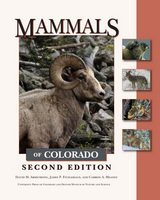 Mammals of Colorado, Second Edition
David M. Armstrong
University Press of Colorado, 2010 Thoroughly revised and updated, Mammals of Colorado, Second Edition is a comprehensive reference on the nine orders and 128 species of Colorado's recent native fauna, detailing each species' description, habitat, distribution, population ecology, diet and foraging, predators and parasites, behavior, reproduction and development, and population status.
An introductory chapter on Colorado's environments, a discussion of the development of the fauna over geologic time, and a brief history of human knowledge of Coloradan mammals provide ecological and evolutionary context. The most recent records of the state's diverse species, rich illustrations (including detailed maps, skull drawings, and photographs), and an extensive bibliography make this book a must-have reference.
Amateur and professional naturalists, students, vertebrate biologists, and ecologists as well as those involved in conservation and wildlife management in Colorado will find value in this comprehensive volume. Co-published with the Denver Museum of Nature & Science
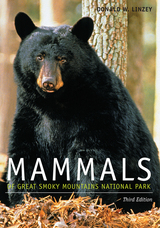 Mammals of Great Smoky Mountains National Park
Donald W. Linzey
University of Tennessee Press, 2016 Visitors to Great Smoky Mountains National Park are likely to see a variety of wildlife, from the small and difficult to observe to the large and spectacular. A wide assortment of animals— salamanders, turtles, lizards, snakes, birds, deer, and bears—inhabit the park. Mammals of Great Smoky Mountains National Park focuses on the park’s fur-bearing animals that nurse their young.
The first edition of Mammals of Great Smoky Mountains National Park was published in 1971, and significant changes have transpired in the past forty-five years: new species have been discovered in the park, reintroductions—some successful and one unsuccessful—have occurred, and a number of taxonomic revisions have taken place. This updated edition contains accounts of seventy-two of the park’s mammals, including opossums, shrews, moles, bats, rabbits, rodents, wolves, raccoons, pumas, and other carnivores and deer and elk.
Donald W. Linzey, who began working in the park in 1963, draws on his extensive research background and combines it with the notes of Arthur Stupka, former chief naturalist and park biologist, and many others who have contributed to knowledge of the mammals in the park. Several new features have been added to the third edition, including the origins of genus and species names, photographs of new species, and skull drawings of some species, which illustrate distinct features. To honor the park’s Cherokee heritage, the Cherokee names for many mammals are now given along with their English names.
Written for laymen and biologists alike, Linzey discusses the distribution, habitat, food habits, predation, and reproductive habits of mammals ranging from the pigmy shrew to the conspicuous black bear.
DONALD W. LINZEY, a professor of biology at Wytheville Community College in Wytheville, Virginia for twenty-four years, is currently a faculty member in the Department of Fish and Wildlife Conservation at Virginia Tech in Blacksburg, Virginia. Among many other books, he is the author of A Natural History Guide to Great Smoky Mountains National Park.
 Mammals of Illinois
Donald F. Hoffmeister
University of Illinois Press, 2002 Donald F. Hoffmeister's authoritative guide provides a detailed profile of all the state's mammals, past and present--from the elephant-sized mastodons that roamed the region during the Ice Age and the black bears and bobcats that early Illinois settlers encountered, to the plethora of creatures that now live on the state's prairies, woodlands, and hills.
Outlining how human activities such as hunting and farming have altered the state's terrain and affected numerous species, Hoffmeister discusses which species have been wiped out, which are endangered or threatened, which no longer live in Illinois but survive elsewhere, and which might inhabit the region in the future.
In this comprehensive study, now available for the first time in paperback, Hoffmeister briefly characterizes the climate, soils, and vegetation of Illinois, particularly as they affect mammals. In addition to detailing mammals known to be present in the area during the Pleistocene and Holocene eras, Hoffmeister identifies each order and family of mammals present in Illinois since 1900. Within each family, each species is characterized by habit, habitat, food, reproduction, population, and variation. These entries are supplemented by tables, anatomical drawings, photographs, and Illinois and United States distribution maps.
Enhanced by sixty color photographs, more than one hundred line drawings, and a glossary of scientific terms, Mammals of Illinois is an indispensable resource for students, teachers, biologists, and nature enthusiasts.
Mammals of Minnesota
Evan Hazard
University of Minnesota Press, 1982 A handbook of classification, identification, distribution, and ecology of 81 species of mammals now or once found wild in Minnesota. Minnesota has been the home of 81 species of mammals. This book is a comprehensive identification guide, also providing information on classification, distribution and ecology of these species. Each mammal is described in terms of size, color of fur, social and reproductive behavior, and interaction with people.
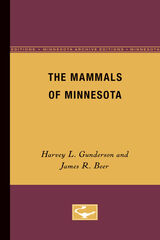 The Mammals of Minnesota
Harvey L. Gunderson and James R. Beer
University of Minnesota Press, 1953
The Mammals of Minnesota was first published in 1953. Minnesota Archive Editions uses digital technology to make long-unavailable books once again accessible, and are published unaltered from the original University of Minnesota Press editions.
For the many Minnesotans interested in the wildlife of their state and for anyone with a special interest in the fur or game animals or in the control of harmful species, this is a practical source of information. Schools will find the book useful in teaching natural history. All the mammal species identified within Minnesota are described, and keys to the classification are given, with careful instructions on how to use the keys. Step- by step directions include photographs of animals, diagrams of the methods described, and 70 maps showing the geographical distribution of species. The material is based primarily on the collections in the Museum of Natural history and the Division of Entomology and Economic Zoology at the University of Minnesota.
Mammals Of Nevada
E. Raymond Hall
University of Nevada Press, 1995 First published in 1946, Mammals of Nevada is a monumental work. Hall and a team of more than sixty scientists, graduate students, and staff members of the Museum of Vertebrate Zoology in Kansas spent innumerable hours trapping, preparing, studying, and documenting thousands of specimens found within the state. This long out-of-print reference contains extensive examinations of the topography, climate, life zones, and floral and faunal areas. Hundreds of illustrations enhance the work. This updated edition features a new foreword and updated taxonomy by Timothy Lawlor.
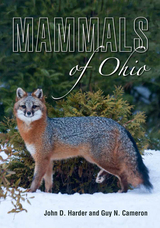 Mammals of Ohio
John D. Harder
Ohio University Press, 2022 An updated, informative review of the status and biology of the fifty-five species of mammals living wild in Ohio, richly illustrated with photographs, maps, drawings, and original artwork. This comprehensive reference illustrates how species within each of the seven orders of mammals in Ohio share modes of reproduction, locomotion, and nutrition, providing a framework for understanding the fascinating world of mammalian biology. Presentations of natural history in each account of the various species are enhanced with descriptions of intriguing adaptations for avoiding demise from predators, food shortages, and the frigid conditions of Ohio winters. The book is richly illustrated with range maps, exquisite skull drawings, beautiful photography, and engaging artwork. Challenges to wildlife conservation are considerable in Ohio, with its vast industrialized urban centers distributed across a largely agricultural landscape. With frequent citations of scientific reports and conservation efforts of the Ohio Division of Wildlife and of other public and private entities, this book instills an appreciation for the rich mammalian fauna of Ohio, as well as knowledge on how to join efforts to protect it. Covering all of the state’s mammals, from tiny, obscure shrews to the magnificent white-tailed deer, Mammals of Ohio is a definitive resource for professional biologists and students. The narrative style throughout the book is accessible, providing the general reader with an appreciation for the full scope of the rich mammalian diversity in the state.
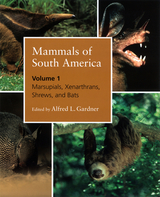 Mammals of South America, Volume 1: Marsupials, Xenarthrans, Shrews, and Bats
Edited by Alfred L. Gardner
University of Chicago Press, 2008 The vast terrain between Panama and Tierra del Fuego contains some of the world’s richest mammalian fauna, but until now it has lacked a comprehensive systematic reference to the identification, distribution, and taxonomy of its mammals. The first such book of its kind and the inaugural volume in a three-part series, Mammals of South America both summarizes existing information and encourages further research of the mammals indigenous to the region. Containing identification keys and brief descriptions of each order, family, and genus, the first volume of Mammals of South America covers marsupials, shrews, armadillos, sloths, anteaters, and bats. Species accounts include taxonomic descriptions, synonymies, keys to identification, distributions with maps and a gazetteer of marginal localities, lists of recognized subspecies, brief summaries of natural history information, and discussions of issues related to taxonomic interpretations.Highly anticipated and much needed, this book will be a landmark contribution to mammalogy, zoology, tropical biology, and conservation biology.
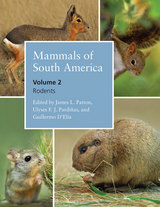 Mammals of South America, Volume 2: Rodents
Edited by James L. Patton, Ulyses F. J. Pardiñas, and Guillermo D’Elía
University of Chicago Press, 2015 The second installment in a planned three-volume series, this book provides the first substantive review of South American rodents published in over fifty years. Increases in the reach of field research and the variety of field survey methods, the introduction of bioinformatics, and the explosion of molecular-based genetic methodologies have all contributed to the revision of many phylogenetic relationships and to a doubling of the recognized diversity of South American rodents. The largest and most diverse mammalian order on Earth—and an increasingly threatened one—Rodentia is also of great ecological importance, and Rodents is both a timely and exhaustive reference on these ubiquitous creatures.
From spiny mice and guinea pigs to the oversized capybara, this book covers all native rodents of South America, the continental islands of Trinidad and Tobago, and the Caribbean Netherlands off the Venezuelan coast. It includes identification keys and descriptions of all genera and species; comments on distribution; maps of localities; discussions of subspecies; and summaries of natural, taxonomic, and nomenclatural history. Rodents also contains a detailed list of cited literature and a separate gazetteer based on confirmed identifications from museum vouchers and the published literature.
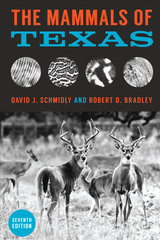 The Mammals of Texas
By David J. Schmidly and Robert D. Bradley
University of Texas Press, 2016 From reviews of previous editions: “This is the standard reference about Texas mammals.” —Wildlife Activist “A must for anyone seriously interested in the wildlife of Texas.” —Texas Outdoor Writers Association News “[This book] easily fills the role of both a field guide and a desk reference, and is written in a style that appeals to the professional biologist and amateur naturalist alike. . . . [It] should prove useful to anyone with an interest in the mammal fauna of Texas or the southern Great Plains.” —Prairie Naturalist The Mammals of Texas has been the standard reference since the first edition was coauthored by William B. Davis and Walter P. Taylor in 1947. Revised several times over the succeeding decades, it remains the most authoritative source of information on the mammalian wildlife of Texas, with physical descriptions and life histories for 202 species, abundant photographs and drawings, and distribution maps. In this new edition, David J. Schmidly is joined by one of the most active researchers on Texas mammals, Robert D. Bradley, to provide a thorough update of the taxonomy, distribution, and natural history of all species of wild mammals that inhabit Texas today. Using the most recent advances in molecular biology and in wildlife ecology and management, the authors include the most current information about the scientific nomenclature, taxonomy, and identification of species, while also covering significant advances in natural history and conservation.
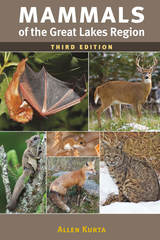 Mammals of the Great Lakes Region, 3rd Ed.
Allen Kurta
University of Michigan Press, 2017 Now in an extensively revised 3rd edition, Mammals of the Great Lakes Region has been an essential reference for countless amateur and professional naturalists since 1957. Easily tucked into a backpack and carried into the field, this heavily illustrated guidebook offers detailed information on 83 species, including each mammal’s appearance, behavior, and natural history, along with an explanation of its scientific name. Species accounts are accompanied by new color photographs plus fully updated distribution maps showing the geographic range in the Great Lakes region and in North America.
A thorough introduction outlines the environmental factors that affect the distribution and abundance of mammals in Great Lakes ecosystems and discusses the impacts of current human activities, including introduction of diseases and climate change. There is also a section on preparing captured specimens for research or teaching, as well as user-friendly keys and quick reference tables to physical measurements and life history data. Brand new in this edition, the book also features detailed illustrations of the tracks of commonly found mammals to assist with year-round identification. Providing the most up-to-date information on mammals in the Great Lakes basin, this book belongs on the shelves of teachers, students, naturalists, and professional biologists throughout the region.
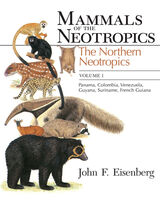 Mammals of the Neotropics, Volume 1: The Northern Neotropics: Panama, Colombia, Venezuela, Guyana, Suriname, French Guiana
John F. Eisenberg
University of Chicago Press, 1989 In recent decades, growing numbers of researchers have been drawn to the rich and highly threatened biotic diversity of the Neotropics, where mammals are among the most difficult animals to observe and study in detail. Mammals of the Neotropics fills the need for a comprehensive, up-to-date survey of existing knowledge of the area's wild mammals, both terrestrial and marine. This first of three planned volumes covers the northern Neotropics, including southern Central America.
John Eisenberg, a leading researcher of Neotropical fauna, begins the volume with a discussion of historical biogeography and contemporary habitats of the northern Neotropics. Each of the chapters that follow presents a mammalian order, with data for all indigenous species. Eisenberg has provided physical descriptions and summaries of range and habitat for nearly 450 species. For those species that have been studied in the field or in captivity, additional notes on natural history are included. For the larger taxa, field keys to help to identify the specimens. Range maps, line drawings, and color plates supplement the text, further aiding identification.
Throughout the book, Eisenberg provides a larger context for the species descriptions. He comments on the diversity of forms within each order, places the Neotropical species in a worldwide geographical perspective, and reviews taxonomic questions and controversies. At the end of each chapter, an extensive bibliography directs readers to related articles on systematics, behavior, ecology, and evolution. Eisenberg concludes with chapters on speciation events and mammalian community ecology.
No comparable account of South and Central American mammals has ever been published in any language. This volume of Mammals of the Neotropics and the forthcoming companion volumes will be an invaluable reference for students and professionals and will help further the research that is so vital to conservation efforts.
 Mammals of the Neotropics, Volume 2: The Southern Cone: Chile, Argentina, Uruguay, Paraguay
Kent H. Redford and John F. Eisenberg
University of Chicago Press, 1992 Mammals of the Neotropics satisfies the need for a comprehensive, up-to-date survey of existing knowledge of South America's terrestrial and marine mammals. No comparable account of South American mammals has ever been published in any language, and this timely work will help encourage the research vital to conservation efforts.
This second of a projected three volumes covers southern South America. The authors discuss the historical biogeography and contemporary habitats of the region and then
provide individual accounts for nearly 360 indigenous species, including information on size, appearance, ecology, behavior, and life history. Range maps, line drawings, and color plates supplement the text. To place the species accounts in a broader context, the authors consider the diversity of animals within each taxonomic group, examine the Neotropical species from a worldwide geographical perspective, and review taxonomic questions and
controversies. Two final chapters deal with the community ecology of mammals and the effects humans have had on the mammalian fauna of the southern cone.
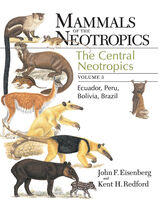 Mammals of the Neotropics, Volume 3: Ecuador, Bolivia, Brazil
John F. Eisenberg and Kent H. Redford
University of Chicago Press, 2000 Despite intense interest in this biologically diverse and ecologically important region, the mammals of South America are still not well known. Filling a large gap in the literature, this volume provides a survey and synthesis of current knowledge of the more than 650 species of land and marine mammals found in Ecuador, Peru, Bolivia, and Brazil.
Third in a series that reviewers have described as "state of the art" (Journal of Biogeography) and "invaluable to anyone interested in the mammalian fauna of the Neotropics" (Quarterly Review of Biology), this volume follows the format of its acclaimed predecessors. Chapters present not only up-to-date taxonomic information but also ecological and behavioral characteristics, conservation status, and distribution maps for most species. Numerous illustrations are provided to assist in field and laboratory identification, including exquisite color and black-and-white plates by Fiona Reid. New to this volume are chapters contributed by experts on the mammalian fossil record of this region and on its current biodiversity and biogeography. An appendix summarizes changes to the nomenclature that have altered the scientific names used in the first two volumes.
Volumes 1 and 2 of Mammals of the Neotropics, which are also available, describe the mammals of Panama, Colombia, Venezuela, Guyana, Suriname, and French Guiana (volume 1) and Chile, Argentina, Uruguay, and Paraguay (volume 2). The fourth and final volume of this series will cover the mammals of Mexico and Central America.
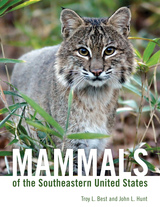 Mammals of the Southeastern United States
Troy L. Best and John L. Hunt
University of Alabama Press, 2020 First comprehensive account of the mammals of the entire southeastern US
The southeastern United States is home to a remarkable and diverse mammalian fauna that is a significant part of the region’s rich natural heritage. Mammals of the Southeastern United States presents accounts of 137 species that currently or previously occurred in the Southeast. Although accessible and useful for the generalist, this book provides an up-to-date compilation of basic knowledge about native and nonnative mammals of the region that is suitable for students of all ages and for professional mammalogists and biologists alike.
This volume profiles common species like the eastern gray squirrel, the white-tailed deer, and the Virginia opossum, but also includes among its accounts many extant species, such as the jaguar and porcupine, that once occurred in the region; native species, like the Caribbean monk seal, that are now extinct; native species that have been extirpated, or wiped out, from all or part of the region, such as the red wolf, cougar, American bison, and elk; and many introduced species, including the Mexican mouse opossum, common squirrel monkey, and capybara.
Each species account includes full-color images of the animal, plates featuring at least three views of its skull, color distribution maps of its approximate geographic range in the Southeast and in North America, and an up-to-date synthesis of several aspects of its biology, including habitat, diet, predators, parasites, diseases, and behaviors. An introductory chapter on conservation summarizes the current status of mammalian populations in the region and provides insight into some of the threats mammals now encounter in the Southeast.
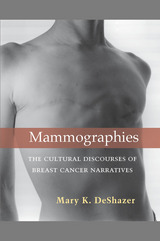 Mammographies: The Cultural Discourses of Breast Cancer Narratives
Mary K. DeShazer
University of Michigan Press, 2015 While breast cancer continues to affect the lives of millions, contemporary writers and artists have responded to the ravages of the disease in creative expression. Mary K. DeShazer’s book looks specifically at breast cancer memoirs and photographic narratives, a category she refers to as mammographies, signifying both the imaging technology by which most Western women discover they have this disease and the documentary imperatives that drive their written and visual accounts of it. Mammographies argues that breast cancer narratives of the past ten years differ from their predecessors in their bold address of previously neglected topics such as the link between cancer and environmental carcinogens, the ethics and efficacy of genetic testing and prophylactic mastectomy, and the shifting politics of prosthesis and reconstruction. Mammographies is distinctive among studies of contemporary illness narratives in its exclusive focus on breast cancer, its analysis of both memoirs and photographic texts, its attention to hybrid and collaborative narratives, and its emphasis on ecological, genetic, transnational, queer, and anti-pink discourses. DeShazer’s methodology—best characterized as literary critical, feminist, and interdisciplinary—includes detailed interpretation of the narrative strategies, thematic contours, and visual imagery of a wide range of contemporary breast cancer memoirs and photographic anthologies. The author explores the ways in which the narratives constitute a distinctive testimonial and memorial tradition, a claim supported by close readings and theoretical analysis that demonstrates how these narratives question hegemonic cultural discourses, empower reader-viewers as empathic witnesses, and provide communal sites for mourning, resisting, and remembering.
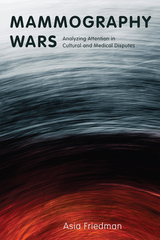 Mammography Wars: Analyzing Attention in Cultural and Medical Disputes
Asia Friedman
Rutgers University Press, 2023 Winner of the 2024 Outstanding Book Award, Social Problems Theory Division, Society for the Study of Social Problems
Mammography is a routine health screening performed forty million times each year in the United States, yet it remains one of the most deeply contested topics in medicine, with national health care organizations supporting conflicting guidelines. In Mammography Wars, sociologist Asia Friedman examines cultural and medical disagreements over mammography. At issue is whether to screen women under age fifty, which is rooted in deeper questions about early detection and the assumed linear and progressive development of breast cancer. Based on interviews with doctors and scientists, interviews with women ages 40 to 50, and newspaper coverage of mammography, Friedman uses the sociology of attention to map the cognitive structure of the “mammography wars,” offering insights into the entrenched nature of debates over mammography that often get missed when applying a medical lens. Friedman’s analysis also suggests the sociology of attention’s unique potential for analyzing cultural conflicts beyond mammography, and even beyond medicine.
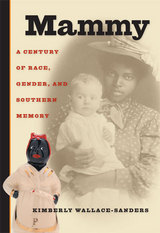 Mammy: A Century of Race, Gender, and Southern Memory
Kimberly Wallace-Sanders
University of Michigan Press, 2008 "An engaging study of 'mammy,' the provocative figure of the African American nanny, cook, and housekeeper in white households . . . Wallace-Sanders reveals . . . disturbing innuendos of mammy still relevant today, in particular the elevation in value of raising others' children at the expense of one's own."
---Choice
"In this insightful analysis of representations of mammy, Wallace-Sanders skillfully illustrates how this core icon of Black womanhood has figured prominently in upholding hierarchies of race, gender, and class in the United States. Far from being a timeless, natural, benign image of domesticity, the idealized mammy figure was repeatedly reworked to accommodate varying configurations of racial rule. No one reading this book will be able to see Gone with the Wind in the same way ever again."
---Patricia Hill Collins, University of Maryland "Kimberly Wallace-Sanders' interdisciplinary approach is first-rate. This expansive and engaging book should appeal to students and scholars in American studies, African American studies, and women's studies."
---Thadious Davis, The University of Pennsylvania
Her cheerful smile and bright eyes gaze out from the covers of old cookbooks, song sheets, syrup bottles, salt and pepper shakers, and cookie jars, and she has long been a prominent figure in fiction, film, television, and folk art. She is Mammy, a figure whose provocative hold on the American psyche has persisted since before the Civil War. But who is Mammy, and where did she come from? Her large, dark body and her round smiling face tower over our imaginations to such an extent that more accurate representations of African American women wither in her shadow. Mammy's stereotypical attributes---a sonorous and soothing voice, raucous laugh, infinite patience, self-deprecating wit, and implicit acceptance of her own inferiority and her devotion to white children---all point to a long-lasting and troubled confluence of racism, sexism, and southern nostalgia. This groundbreaking book traces the mammy figure and what it has symbolized at various historical moments that are linked to phases in America's racial consciousness. The author shows how representations of Mammy have loomed over the American literary and cultural imagination, an influence so pervasive that only a comprehensive and integrated approach of this kind can do it justice. The book's many illustrations trace representations of the mammy figure from the nineteenth century to the present, as she has been depicted in advertising, book illustrations, kitchen figurines, and dolls. The author also surveys the rich and previously unmined history of the responses of African American artists to the black mammy stereotype, including contemporary reframings by artists Betye Saar, Michael Ray Charles, and Joyce Scott. Kimberly Wallace-Sanders is Associate Professor of the Graduate Institute of Liberal Arts and Women's Studies at Emory University. She is editor of Skin Deep, Spirit Strong: The Black Female Body in American Culture.
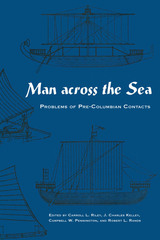 Man Across the Sea: Problems of Pre-Columbian Contacts
Edited by Carroll L. Riley, J. Charles Kelley, Campbell W. Pennington, and Robert L. Rands
University of Texas Press, 1971 Whether humans crossed the seas between the Old World and the New in the times before Columbus is a tantalizing question that has long excited scholarly interest and tempted imaginations the world over. From the myths of Atlantis and Mu to the more credible, perhaps, but hardly less romantic tales of Viking ships and Buddhist missionaries, people have speculated upon what is, after all, not simply a question of contact, but of the nature and growth of civilization itself. To the specialist, it is an important question indeed. If people in the Western Hemisphere and in the Eastern Hemisphere developed their cultures more or less independently from the end of the last Ice Age until the voyages of Columbus, the remarkable similarities between New World and Old World cultures reveal something important about the evolution of culture. If, on the other hand, there were widespread or sustained contacts between the hemispheres in pre-Columbian times, these contacts represent events of vast significance to the prehistory and history of humanity. Originally delivered at a symposium held in May 1968, during the national meeting of the Society for American Archaeology, the papers presented here, by scholars eminent in the field, offer differing points of view and considerable evidence on the pros and cons of pre-Columbian contact between the Old World and the New. Various kinds of data—archaeological, botanical, geographical, and historical—are brought to bear on the problem, with provocative and original results. Introductory and concluding remarks by the editors pull together and evaluate the evidence and suggest ground rules for future studies of this sort. Man across the Sea provides no final answers as to whether people from Asia, Africa, or Europe visited the American Indian before Columbus. It does, however, present new evidence, suggested lines of approach, and a fresh attempt to delineate the problems involved and to establish acceptable canons of evidence for the future.
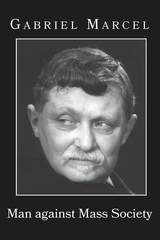 Man against Mass Society
Gabriel Marcel
St. Augustine's Press, 2008 The central theme of this important book is that we are paying the price of an arrogance that refuses to recognize mystery. The author invites the reader to enter into the argument that he holds with himself on a great number of problems. Written in the early 1950s, Marcel’s discussion of these topics are remarkably contemporary, e.g.: * Our crisis is a metaphysical, not merely social, one. * What a man is depends partly on what he thinks he is, and a materialistic philosophy turns men into things. * Can a man be free except in a free country? * Stoicism is no longer a workable philosophy because today pressure can be put on the mind as well as on the body. * Technical progress is not evil in itself, but a technique is a means that, regarded as an end, can become either an idol or an excuse for self-idolatry. State control of scientific research, leading to a concentration on new means of destruction, is a calamity. * Fanaticism is an opinion that refuses to argue, and so the fanatic is an enemy of truth. * The kind of unification that science is bringing about today is really an ironing out of differences, but the only valuable kind of unity is one that implies a respect for differences. * We must beware of thinking in terms of great numbers and so blinding ourselves to the reality of individual suffering. Our philosophical approach to being is made possible only by our practical approach to our neighbor. * We must encourage the spirit of fraternity and distrust the kind of egalitarianism that is based on envy and resentment. * No man however humble should feel that he cannot spread the light among his friends. No easy solution is offered, but the author conveys his own faith that ultimately love and intelligence will triumph.
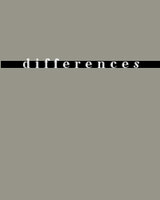 Man and Beast, Volume 15
Elizabeth Weed and Ellen Rooney, eds.
Duke University Press The question of what it means to be human is at the core of Western philosophical and scientific inquiry. As conceptualized in the Western tradition, “humanity” has been understood and defined in opposition to the animal, which is said to lack the rationality and language that we adduce as the clearest evidence of our difference from beasts. Recent scientific research and rigorous examinations of taxonomy, however, have raised controversial questions regarding the relationship between humans and animals. Man and Beast poses these central philosophical and scientific questions from a different perspective, not simply asking where the line is or ought to be drawn between man and beast but examining and analyzing the stakes in transgressing or maintaining species barriers. The contributors to Man and Beast, writing from an array of academic disciplines, collectively rethink human relationships with other animals. Pointing to the ethical implications of taxonomic classifications and distinctions drawn by the natural sciences, one essay argues that these categories are neither as abstract nor as neutral as commonly assumed. Another essay offers a historicizing study of species barriers to examine the way in which zoological classifications have been breached, relegating some humans to the category of “animal” or, alternately, including in the human circle nonhuman species. Other essays consider the attribution of a human speech impediment to such famous talking cartoon animals as Porky Pig, read the social implications of such popular animal-human hybrids as “Bat Boy” of the tabloid press, and examine the representation of animals as moral agents in fables dating to Aesop, noting the appearance of such tales during periods of social upheaval and instability. All of these suggest that the category of “beast,” like that of human being, has never been either homogeneous or stable. Contributors. Howard Bloch, Judith L. Goldstein, Harriet Ritvo, Marc Shell, Barbara Herrnstein Smith
Man and Nature: Or, Physical Geography as Modified by Human Action
George Marsh
Harvard University Press, 1965 George Perkins Marsh's Man and Nature was the first book to attack the American myth of the superabundance and the inexhaustibility of the earth. It was, as Lewis Mumford said, "the fountainhead of the conservation movement," and few books since have had such an influence on the way men view and use land. "It is worth reading after a hundred years," Mr. Lowenthal points out, "not only because it taught important lessons in its day, but also because it still teaches them so well...Historical insight and contemporary passion make Man and Nature an enduring classic."
Man and the Modern City: Ten Essays
Elizabeth Geen
University of Pittsburgh Press, 1966 No single view of American cities captures the many problems of urban life-whether the city is analyzed by a politician, an architect, an urban planner, a sociologist, or a psychologist. Man and the Modern City presents the view of ten distinguished urban critics whose variety of approaches places the crucial issues of the city in a broad perspective.
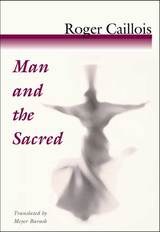 Man and the Sacred
Roger Caillois
University of Illinois Press, 1959 Throughout the world, people believe that much of what they do is accidental, ordinary, and inconsequential, while other acts can bring on divine retribution or earn eternal grace. In Man and the Sacred, Caillois demonstrates how humanity's ambiguous attitude toward the sacred influences behavior and culture.
Drawing on a diverse array of ethnographic contexts, including the sexual rituals of the Ba-Thong of South Africa and evidence drawn from aboriginal Australian, Eskimo, and traditional Chinese social systems, Caillois analyzes the role of the forbidden in the social cohesion of the group. He examines the character of the sacred in the light of specific instances of taboos and transgressions, exploring wide differences in attitudes toward diet and sex and extreme behaviors associated with the sacred, such as rapture and paroxysm. He also discusses the festival--an exuberant explosion following a period of strict repression--and compares its functions with those of modern war.
A classic study of one of the most fundamental aspects of human social and spiritual life, Man and the Sacred--presented here in Meyer Barash's superb English translation--is a companion volume to Caillois's Man, Play and Games.
 Man and Wife in America: A History
Hendrik Hartog
Harvard University Press, 2002 In nineteenth-century America, the law insisted that marriage was a permanent relationship defined by the husband's authority and the wife's dependence. Yet at the same time the law created the means to escape that relationship. How was this possible? And how did wives and husbands experience marriage within that legal regime? These are the complexities that Hendrik Hartog plumbs in a study of the powers of law and its limits.
Exploring a century and a half of marriage through stories of struggle and conflict mined from case records, Hartog shatters the myth of a golden age of stable marriage. He describes the myriad ways the law shaped and defined marital relations and spousal identities, and how individuals manipulated and reshaped the rules of the American states to fit their needs. We witness a compelling cast of characters: wives who attempted to leave abusive husbands, women who manipulated their marital status for personal advantage, accidental and intentional bigamists, men who killed their wives' lovers, couples who insisted on divorce in a legal culture that denied them that right.
As we watch and listen to these men and women, enmeshed in law and escaping from marriages, we catch reflected images both of ourselves and our parents, of our desires and our anxieties about marriage. Hartog shows how our own conflicts and confusions about marital roles and identities are rooted in the history of marriage and the legal struggles that defined and transformed it.
 The Man Behind the Mask: Journey of an Orthopaedic Surgeon
Thomas H. Mallory, MD
University of Missouri Press, 2007
The perils of aging are many, but the debilitating effects of serious illness loom large. In this stirring memoir, readers will discover a man who improved the lives of many arthritis sufferers before himself succumbing to a cruel debilitating disease. The Man behind the Mask tells the story of Thomas Mallory, who was inspired to become a doctor after undergoing surgery for a high school football injury. He went on to become a renowned surgeon and a pioneer in joint replacement. In 2002, his successful career came to an abrupt halt when he was diagnosed with Parkinson’s disease.
Mallory was one of the first surgeons in the United States to see the potential for joint replacement technology, and in this memoir he describes not only the nuances of introducing hip replacement surgery but also the systems that he established to make it a highly successful operation. He tells how he overcame initial resistance to the procedure and became a respected teacher of the technology, training many surgeons who went on to successful careers, lecturing about his procedure around the world, and also seeing VIP patients who journeyed to Ohio just to be operated on by him.
As a pioneer in this type of operation, Mallory first recognized the value of using prosthetic innovation and development. He became a proponent of modularity in joint replacement surgery, which allowed a surgeon to customize a prosthesis to a patient’s joint in the operating room. His innovations, along with those of Dr. William Head, resulted in the introduction in 1983 of the Mallory-Head Hip System—a technology still in use today and one that has offered relief to thousands of patients.
Tracing the joys and sorrows of his own career, Mallory dispels the myth that surgeons are emotionally invulnerable and cold. He offers his perspective on the pursuit of medicine as a profession, on the doctor-patient relationship, and on litigious challenges to physicians. He also commends the benefits of family and leisure and the blessing of life in general while offering insight into the management of an incurable disease.
In our skeptical era, Thomas Mallory is a shining example of a prominent scientist who has maintained his faith in God throughout the highs and lows of life. The Man behind the Mask is an inspiring account for fellow professionals and general readers, as well as for those who have benefited from the procedures he introduced.
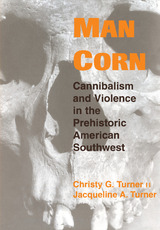 Man Corn: Cannibalism and Violence in the Prehistoric American Southwest
Christy G Turner
University of Utah Press, 1999 This study of prehistoric violence, homicide, and cannibalism explodes the myth that the Anasazi and other Southwest Indians were simple, peaceful farmers.
Until quite recently, Southwest prehistory studies have largely missed or ignored evidence of violent competition. Christy and Jacqueline Turner’s study of prehistoric violence, homicide, and cannibalism explodes the myth that the Anasazi and other Southwest Indians were simple, peaceful farmers. Using detailed osteological analyses and other lines of evidence the Turners show that warfare, violence, and their concomitant horrors were as common in the ancient Southwest as anywhere else in the world.
The special feature of this massively documented study is its multi-regional assessment of episodic human bones assemblages (scattered floor deposits or charnel pits) by taphonomic analysis, which considers what happens to bones from the time of death to the time of recovery. During the past thirty years, the authors and other analysts have identified a minimal perimortem taphonomic signature of burning, pot polishing, anvil abrasions, bone breakage, cut marks, and missing vertebrae that closely match the signatures of animal butchering and is frequently associated with additional evidence of violence. More than seventy-five archaeological sited containing several hundred individuals are carefully examined for the cannibalism signature. Because this signature has not been reported for any sites north of Mexico, other than those in the Southwest, the authors also present detailed comparisons with Mesoamerican skeletal collections where human sacrifice and cannibalism were known to have been practiced. The authors review several hypotheses for Southwest cannibalism: starvation, social pathology, and institutionalized violence and cannibalism. In the latter case, they present evidence for a potential Mexican connection and demonstrate that most of the known cannibalized series are located temporally and spatially near Chaco great houses.
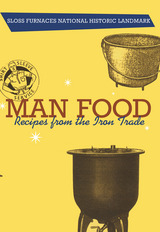 Man Food: Recipes from the Iron Trade
Sloss Furnaces Historical Landmark
University of Alabama Press, 2007 The secret history of manly eating in the Heart of Dixie Man Food: Recipes from the Iron Trade is a flavorful tribute to Alabama’s industrial soul and culinary heart. Born from the legendary Sloss Furnaces in Birmingham—once the beating heart of the Magic City’s iron industry—this cookbook blends Southern tradition, foundry grit, and backyard hospitality into one unforgettable volume. Collected from the pages of Pig Iron Rough Notes, a magazine once circulated among Alabama’s ironworkers, these recipes reflect the lives of men who forged metal by day and cooked with cast iron by night. Inside, you’ll find dishes like Brunswick Stew, Catfish Chowder, and Bean Hole Beans—hearty meals rooted in Alabama’s outdoors, work camps, and family kitchens. With colorful stories, vintage illustrations, and a deep appreciation for cast-iron cooking, Man Food celebrates the “Gentlemen Cooks” of the South—men who knew that good food and good company were just as important as hard work. Whether you're a native Alabamian, a history buff, or a lover of Southern foodways, this book offers a delicious slice of Alabama culture. Fire up your skillet, pour a cup of camp coffee, and taste the legacy of the Iron Trade—Alabama style.
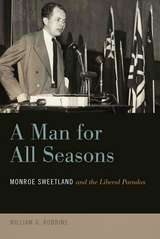 A Man for All Seasons: Monroe Sweetland and the Liberal Paradox
William Robbins
Oregon State University Press, 2015 The life of prominent Oregon political leader Monroe Sweetland spans the spectrum of 20th-century America. Through seven decades, Sweetland experienced the economic collapse of the Great Depression, the unparalleled violence of a nation at war, the divisiveness of Cold War politics, and the cultural and political turmoil of the Vietnam War.
Historian William G. Robbins illuminates the wrenching transformation of American political culture in A Man for All Seasons: Monroe Sweetland and the Liberal Paradox. Racial and economic inequalities motivated much of Sweetland’s civic life, including his lifelong memberships in the American Civil Liberties Committee, the National Association for the Advancement of Colored People, the Urban League, the Japanese American Citizens League, and the Red Cross, where Sweetland worked repatriating American prisoners of war after Japan’s surrender.
Robbins’ portrait is holistic, exploring Sweetland’s socialist beginnings, inconsistencies in his politics—especially during the Cold War—and his regional legacy. He was the most important person in the resurgence of the modern, liberal Oregon Democratic Party from the late 1940s to the 1960s. He joined the National Education Association in 1964 and became the driving force behind the Bilingual Education Act of 1968 and the fight for the age-18 vote, achieved in the ratification of the 26th amendment in 1971. Monroe Sweetland was a nationally prominent figure, whose fights bequeathed to modern America important legislation that shaped its political landscape.
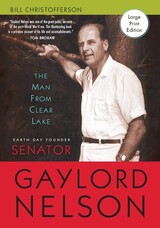 The Man from Clear Lake: Earth Day Founder Senator Gaylord Nelson
Bill Christofferson
University of Wisconsin Press, 2009 On Earth Day 1970 twenty million Americans displayed their commitment to a clean environment. It was called the largest demonstration in human history, and it permanently changed the nation’s political agenda. By Earth Day 2000 participation had exploded to 500 million people in 167 countries.
The seemingly simple idea—a day set aside to focus on protecting our natural environment—was the brainchild of U.S. Senator Gaylord Nelson of Wisconsin. It accomplished, far beyond his expectations, his lifelong goal of putting the environment onto the nation’s and the world’s political agendas.
A remarkable man, Nelson ranks as one of history’s leading environmentalists. He also played a major role as an early, outspoken opponent of the Vietnam War, and as a senate insider was a key player in civil rights, poverty, civil liberties and consumer protection issues.
The life of Nelson, a small town boy who learned his values and progressive political principles at an early age, is woven through the political history of the twentieth century. Nelson’s story intersects at times with Fighting Bob La Follette, Joe McCarthy, and Bill Proxmire in Wisconsin, and with George McGovern, Lyndon Johnson, Hubert Humphrey, Russell Long, Walter Mondale, John F. Kennedy, and others on the national scene. Winner, Elizabeth A. Steinberg Prize, University of Wisconsin Press
Man from Nebraska: A Play
Tracy Letts
Northwestern University Press, 2006 A luxury sedan, a church pew, a cafeteria table, a favorite TV show, and visits to a nursing home form the comfortable cycles of the dull daily life of middle-aged insurance salesman Ken Carpenter. Then one night, he awakens to find that he no longer believes in God. To the surprise of his very understanding (to a point) wife and his two grown daughters who think he has lost his mind, Ken decides to find himself and his faith by flying to London, where he was stationed while in the Air Force. He navigates through the new and somewhat dangerous realm of British counter-culture and ultimately finds his way back home. Tracy Letts's moving, funny, and spiritually complex play dares to ask the big questions, and by doing so, reveals the hidden yearning and emotion that spur the eccentric behavior of seemingly ordinary people.
 Man in a Hurry: Murray MacLehose and Colonial Autonomy in Hong Kong
Ray Yep
Hong Kong University Press, 2024 A careful analysis of the intricacies of decolonizing British-ruled Hong Kong.
Man in a Hurry explores the latest available archival materials and re-examines MacLehose’s pivotal governorship in Hong Kong (1971–1982). MacLehose arrived in the challenging 1970s, when there were expectations for social reforms, uneasiness in the relationship between Hong Kong and London, and the 1997 factor looming large. The governor successfully carried out various social reforms and he also handled various major issues, including the anti-corruption campaign, the Vietnamese refugee crisis, and the granting of land lease of the New Territories beyond 1997. Yep unveils the tension and bargaining between the British government and explains how interest of the colony could be asserted, defended, and negotiated. This book is an important study of Hong Kong’s "golden years" when the city’s economy took off. It is a significant contribution to our understanding of how local autonomy was defined.
A Man in Charge: A Novel
Morris Philipson
University of Chicago Press, 2000 An old-fashioned man of character, Conrad Taylor is executive vice-president of a eastern university who, after leading a satisfying and well-ordered life, finds himself suddenly on shaky ground, struggling to do the right thing in the face of crisis, confrontation, and opportunity. A Man in Charge is an intricate novel about the uncertainties of personal power and the discovery of its limits.
 The Man in Song: A Discographic Biography of Johnny Cash
John M. Alexander
University of Arkansas Press, 2018 There have been many books written about Johnny Cash, but The Man in Song is the first to examine Cash’s incredible life through the lens of the songs he wrote and recorded. Music journalist and historian John Alexander has drawn on decades of studying Cash’s music and life, from his difficult depression-era Arkansas childhood through his death in 2003, to tell a life story through songs familiar and obscure. In discovering why Cash wrote a given song or chose to record it, Alexander introduces readers anew to a man whose primary consideration of any song was the difference music makes in people’s lives, and not whether the song would become a hit. The hits came, of course. Johnny Cash sold more than fifty million albums in forty years, and he holds the distinction of being the only performer inducted into the Rock and Roll Hall of Fame, the Country Music Hall of Fame, the Songwriters Hall of Fame, and the Gospel Music Hall of Fame. The Man in Song connects treasured songs to an incredible life. It explores the intertwined experience and creativity of childhood trauma. It rifles through the discography of a life: Cash’s work with the Tennessee Two at Sam Phillips’s Sun Studios, the unique concept albums Cash recorded for Columbia Records, the spiritual songs, the albums recorded live at prisons, songs about the love of his life, June Carter Cash, songs about murder and death and addiction, songs about ramblers, and even silly songs. Appropriate for both serious country and folk music enthusiasts and those just learning about this musical legend, The Man in Song will appeal to a fan base spanning generations. Here is a biography for those who first heard “I Walk the Line” in 1956, a younger generation who discovered Cash through songs like his cover of Trent Reznor’s “Hurt,” and everyone in between.
The Man in the Banana Trees
Marguerite Sheffer
University of Iowa Press, 2024 PEN/Robert W. Bingham Prize for Debut Short Story Collection 2025, Finalist
A Debutiful “Most Anticipated Debut Book of 2024”
One of Electric Literature’s Most Exciting Debut Short Story Collection of 2024
Named a Best Book of 2024 by Debutiful and Electric Literature
The stories in The Man in the Banana Trees take place in the past, present, and future—from the American Gulf South to the orbit around Jupiter. We meet teachers and students, ghosts and aliens. An ice cream consultant in the year 2036 predicts a devastating flavor trend and a disgruntled New England waiter investigates a mysterious tanker crash. Although wildly varied in setting, length, and genre, a thread of the fantastic unites these stories, as characters struggle to understand that thing lurking at the edge of their perception: something sinister, or maybe—miraculous.
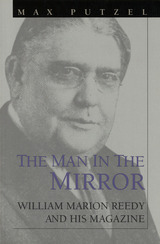 The Man in the Mirror: William Marion Reedy and His Magazine
Max Putzel
University of Missouri Press, 1998
A flamboyant and controversial figure, William Marion Reedy was one of the most successful literary entrepreneurs of his day. Editor of the Mirror, a St. Louis weekly, from 1891 to 1920, Reedy played a large role in breaking down the genteel literary tradition, developing a native poetry, and helping to form some fifty significant poets. Emily Dickinson, Stephen Crane, Ezra Pound, Edwin Arlington Robinson, Amy Lowell, Sara Teasdale, Carl Sandburg, and Vachel Lindsay are just a few of the writers whose works Reedy featured in his magazine.
The Man in the Mirror offers a colorful description of Reedy's boyhood in St. Louis during the turbulent period following the Civil War. This well-documented biography follows Reedy throughout his years as a reporter in the early days of the St. Louis Post-Dispatch and Globe-Democrat and as editor of the St. Louis Star. Only seven years after Reedy founded the Mirror as a national journal of opinion--a potpourri of political comment, social gossip, and literary miscellany—the magazine's circulation far surpassed that of the Dial, Atlantic Monthly, or Nation.
Max Putzel truly conveys the spirit and personality of Reedy by carefully examining his life within the context of the literary world he influenced so significantly. Full chapters are devoted to his relationships with Theodore Dreiser, Ezra Pound, Vachel Lindsay, Amy Lowell, and others. Edgar Lee Masters, whose Spoon River Anthology first appeared in the Mirror, called Reedy both the "Literary Boss of the Middle West" and his best friend. In fact, Reedy had quite a range of friends, from librarians to politicians, St. Louis locals to Teddy Roosevelt. His personal effect on people, writers and readers alike, is what has made him such an important historical figure.
It is a tribute to Reedy's critical judgment that the reputations he helped to build would later overshadow his own. The Man in the Mirror, lauded as "the first substantial study of Reedy's work" by American Literature, reveals Reedy's notable contribution to the literary world.
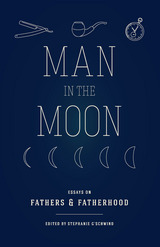 Man in the Moon: Essays on Fathers and Fatherhood
Stephanie G'Schwind
University Press of Colorado, 2014 "Science claims it will one day be able to eliminate fathers from the equation by mating bone marrow with ovum. When that day comes, I imagine this book, along with a handful of other works (King Lear, Fun Home) will become even more necessary. Herein find the blueprints for the mystery, the maps for the uncharted, the keys to the archetype."
—Nick Flynn, author of The Reenactments and Another Bullshit Night in Suck City
"At this moment, I find myself at loose ends, lost in the various vacuums left by my father's dying and my sons' departures out into the voids. Yet this stunning constellation of essays centered me, became for me fine instruments of reckoning of where to stand in the ceaseless entropic dynamic of kin, of paternal keening. These waxing meditations demonstrate the inflationary universe, the heft and velocity of that big ol' nothing. They elegantly fill, with sober hope and the balm of joy, the terrifying, infinite spaces between those waning stars."
—Michael Martone, author of Michael Martone and Four for a Quarter
"What an unreachable mystery the father is, preoccupied, unknowable, pervasive. In these fascinating essays, a shared portrait emerges as writers articulate the perpetual puzzle of the father and, with grace and candor, explore what it means to not know him, to never know him. As one voice, these essays investigate the man—his inventories, his myths, his mere traces—who makes up our horizons, who forever shimmers there beyond our collective grasp."
—Susanna Sonnenberg, author of Her Last Death and She Matters: A Life in Friendships
Selected from the country's leading literary journals and publications—Crazyhorse, Colorado Review, The Nervous Breakdown, Creative Nonfiction, Georgia Review, Gulf Coast, The Missouri Review, The Normal School, and others—Man in the Moon brings together essays in which sons, daughters, and fathers explore the elusive nature of this intimate relationship and find unique ways to frame and understand it: through astronomy, arachnology, storytelling, map-reading, television, puzzles, DNA, and so on. In the collection's title essay, Bill Capossere considers the inextricable link between his love of astronomy and memories of his father: "The man in the moon is no stranger to me,” he writes. "I have seen his face before, and it is my father's, and his father's, and my own.” Other essays include Dinty Moore's "Son of Mr. Green Jeans: A Meditation on Missing Fathers,” in which Moore lays out an alphabetic investigation of fathers from popular culture—Ward Cleaver, Jim Anderson, Ozzie Nelson—while ruminating on his own absent father and hesitation to become a father himself. In "Plot Variations,” Robin Black attempts to understand, through the lens of teaching fiction to creative writing students, her inability to attend her father's funeral. Deborah Thompson tries to reconcile her pride in her father's pioneering research in plastics and her concerns about their toxic environmental consequences in "When the Future Was Plastic.” At turns painfully familiar, comic, and heartbreaking, the essays in this collection also deliver moments of seari
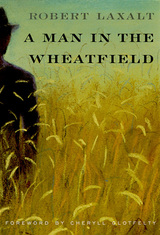 A Man in the Wheatfield
Robert Laxalt
University of Nevada Press, 2002 Set in a small Nevada town of Italian immigrants, this allegorical tale illustrates the human traits of evil and fear. Laxalt relays his shocking story simply and concisely. Father Savio Lazzaroni is obsessed with a vision of evil. Mayor Manuel Cafferata is only concerned with his own standing in a tiny village peopled with Italian immigrants. Into their isolated town comes Smale Calder, the first outsider to set up business in the tightly knit society. The events that befall these three men and the villagers reveal the chilling ways in which people deal with fear and prejudice. When Calder’s secret passion for rattlesnakes is discovered, the lives of all involved are changed in a dramatic sequence of emotions and events. Laxalt’s quiet buildup of suspense and violence will sneak up on readers and leave them questioning the meaning of good and innocence. One of the best works written in the West, this novella was honored alongside Hemingway and Bellow upon its first release in 1964.
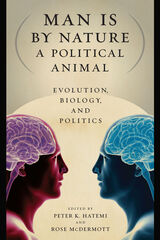 Man Is by Nature a Political Animal: Evolution, Biology, and Politics
Edited by Peter K. Hatemi and Rose McDermott
University of Chicago Press, 2011 In Man Is by Nature a Political Animal, Peter K. Hatemi and Rose McDermott bring together a diverse group of contributors to examine the ways in which evolutionary theory and biological research are increasingly informing analyses of political behavior. Focusing on the theoretical, methodological, and empirical frameworks of a variety of biological approaches to political attitudes and preferences, the authors consider a wide range of topics, including the comparative basis of political behavior, the utility of formal modeling informed by evolutionary theory, the genetic bases of attitudes and behaviors, psychophysiological methods and research, and the wealth of insight generated by recent research on the human brain. Through this approach, the book reveals the biological bases of many previously unexplained variances within the extant models of political behavior. The diversity of methods discussed and variety of issues examined here will make this book of great interest to students and scholars seeking a comprehensive overview of this emerging approach to the study of politics and behavior.
Man Killed by Pheasant and Other Kinships
John T. Price
University of Iowa Press, 2012 John Price’s Man Killed by Pheasant is a loving ode to the prairies of the Midwest, to west central Iowa, and to family connections that stretch from his Swedish ancestors to his parents to his wife and children. Throughout he embraces “the opportunity, as always, to settle, to remember, and be ready.” This quest sounds more portentous than it is once enriched with Price’s gentle humor and endearing empathy. Sharing stories of home, secrets of landscape, and binding ties to both, he weaves history and memory to create permanent kinships for himself and for his readers.
 Man Made God: The Meaning of Life
Luc Ferry
University of Chicago Press, 2002 What happens when the meaning of life based on a divine revelation no longer makes sense? Does the quest for transcendence end in the pursuit of material success and self-absorption?
Luc Ferry argues that modernity and the emergence of secular humanism in Europe since the eighteenth century have not killed the search for meaning and the sacred, or even the idea of God, but rather have transformed both through a dual process: the humanization of the divine and the divinization of the human. Ferry sees evidence for the first of these in the Catholic Church's attempts to counter the growing rejection of dogmatism and to translate the religious tradition into contemporary language. The second he traces to the birth of modern love and humanitarianism, both of which demand a concern for others and even self-sacrifice in defense of values that transcend life itself. Ferry concludes with a powerful statement in favor of what he calls "transcendental humanism"—a concept that for the first time in human history gives us access to a genuine spirituality rooted in human beings instead of the divine.
Man Made: Searching for Dads, Daddies, Father Figures, and Fatherhood
Steve Majors
University of Wisconsin Press, 2025 Not all little boys want to grow up to be like their dads. The shy ones, the sensitive ones, the ones people mock as strange or call queer—sometimes they want to grow up to be loved by men who stand in for their fathers. They’ll put up with bullying from an older brother, taunts from the gym teacher, long work hours from a boss, and even discipline from a gay daddy, all as a means to discover what kind of man they truly want to be.
In this poignant and provocative memoir, Steve Majors takes us on a journey of his own self-discovery as he grows from a gay boy in search of a father figure to a gay man grappling with what it means to be a father himself. In doing so, Majors creates various snapshots of time in which his—and the world’s—understanding of what it means to be a gay man changes.
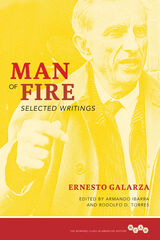 Man of Fire: Selected Writings
Ernesto Galarza, Edited by Armando Ibarra and Rodolfo D. Torres
University of Illinois Press, 2013 Activist, labor scholar, and organizer Ernesto Galarza (1905–1984) was a leading advocate for Mexican Americans and one of the most important Mexican American scholars and activists after World War II. This volume gathers Galarza's key writings, reflecting an intellectual rigor, conceptual clarity, and a constructive concern for the working class in the face of America's growing influence over Mexico's economic system. Throughout his life, Galarza confronted and analyzed some of the most momentous social transformations of the twentieth century. Inspired by his youthful experience as a farm laborer in Sacramento, he dedicated his life to the struggle for justice for farm workers and urban working-class Latinos and helped build the first multiracial farm workers union, setting the foundation for the emergence of the United Farm Workers Union. He worked to change existing educational philosophies and curricula in schools, and his civil rights legacy includes the founding of the Mexican American Legal Defense Fund (MALDEF) and the National Council of La Raza (NCLR). In 1979, Galarza was the first U.S. Latino to be nominated for the Nobel Prize in Literature, for works such as Strangers in Our Fields, Merchants of Labor, Barrio Boy, and Tragedy at Chualar.
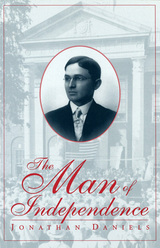 The Man of Independence
Jonathan Daniels
University of Missouri Press, 1998 Having worked closely with Harry S. Truman in the triumphant campaign of 1948, Jonathan Daniels believed that President Truman was an "everyday" American, an ordinary human who aspired to greatness and achieved it. Thus, it was Daniels's intention that The Man of Independence not be a conventional biography; rather, he wanted it to reveal in real terms "the Odyssey of the 'everyday' American through our times." As a result, this comprehensive work not only presents Truman's life, it also details the development of the America in which the president grew up. Truman spent his youth and his political life believing that old- fashioned, determined conservatism was vital to the preservation of personal liberty. Daniels re-creates Truman's remarkable journey through life—employing newspapers, letters, memos, family papers, as well as interviews with Truman, his family, and his close acquaintances. In the process, Daniels provides powerful evocations of the time during which Truman lived. Daniels tells this extraordinary story by following this simple farm boy from Missouri through his youth and his years as a farmer, a veteran, and a businessman, on to his early career in politics, and then his presidency. Along the way, Daniels deals with issues, events, and ideas that were part of Missouri and American politics in the 1920s, 1930s, and 1940s; ultimately, he gives us the Truman who was to become the legend. This inside account provides thought-provoking and personal information about Truman. His relationship with Thomas Pendergast, the seeming conflict between Truman's midwestern conservatism and his belief in equality for American blacks, and his momentous decision to use the atomic bomb to end the war—these are just a few of the topics touched on. Ending in 1949 when Truman was for the second time sworn in as president, The Man of Independence provides a fascinating and valuable look at one of America's most important and beloved presidents, as well as a crucial look at the America from which he emerged.
The Man of Many Devices, Who Wandered Full Many Ways: Festschrift in Honor of János M. Bak
Balázs Nagy
Central European University Press, 1999 More than sixty friends and colleagues pay tribute to the distinguished professor János Bak's 70th birthday. Notable contributors from many countries dedicate previously unpublished essays and articles in this celebratory Festschrift. Reflecting the intellectual calibre of János Bak, scholars not only of medieval history, but also from the fields of modern history, philosophy, linguistics, art history and political science provide a broad range of perspectives on a wide range of disciplinary areas thus allowing a wide readership audience.
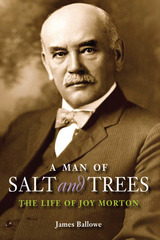 A Man of Salt and Trees: The Life of Joy Morton
James Ballowe
Northern Illinois University Press, 2016
A Man of Salt and Trees is the first full-length biography of Joy Morton (1855-1934), founder of The Morton Arboretum—an internationally acclaimed outdoor museum of woody plants—and Morton Salt—the brand that for over a century has been a household name in the United States. Joy Morton’s story begins in the pre–Civil War Nebraska Territory and concludes in the midst of the Great Depression in Chicago, the city in which he lived for over a half century. Using the voluminous correspondence of the Morton family, Ballowe tells the story of the Nebraska farm boy who grew up to be a small town banker who became a leading citizen of Chicago and Illinois and a major figure in the nation’s economic and technological development during the late 19th and early 20th centuries.
Morton left his mark in several areas, from business and city planning to transportation and environmental preservation. He was a contributor to the development of Daniel H. Burnham and Edward Bennett’s 1909 Plan of Chicago, which continues to affect the way Chicagoans protect the Lakefront and approach transportation and park issues throughout the region. During the last three decades of his life, Morton served on the Chicago Plan Commission. His interest in transportation led him to become an investor and a director in railroad transportation and a champion of inland waterway traffic. He also single-handedly financed early advancements of the teletype, a technology that advanced the economic and cultural development of the 20th century.
Toward the end of his life, Morton funded the University of Chicago’s explorations of Mississippian Indian culture in central Illinois and traveled throughout the world visiting ancient as well as modern cultures and gardens. The Morton Arboretum stands today as a natural expression of a desire Joy Morton had from childhood, when he learned from his father, the founder of Arbor Day, and his mother, a dedicated gardener, that a necessary complement to a good life is the cultivation and preservation of the environment.
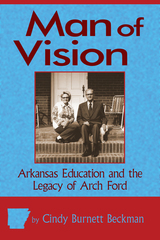 Man of Vision: Arkansas Education and the Legacy of Arch Ford
Cindy Burnett Beckman
Butler Center for Arkansas Studies, 2016 As commissioner of the Arkansas Department of Education from 1953 to 1978, Arch Ford served under five governors. His vision was to expand educational opportunities because he believed education was the foundation for improving people’s lives. Throughout his career, he campaigned for increased educational funding, better-qualified teachers, and higher teachers’ salaries. Ford helped lead the state in peacefully integrating its schools and established twenty-three vocational-technical schools across the state. During Ford’s tenure, the Arkansas Children’s Colony was established to provide educational services to the developmentally disabled, and the Arkansas Educational Television Network was set up to provide instructional programming across the state. The state also expanded educational opportunities to include kindergarten, special education, community colleges, and adult education. His leadership left Arkansas with a strong educational system that continued to advance. This was his legacy.
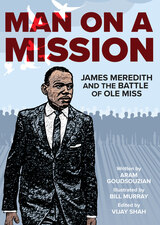 Man on a Mission: James Meredith and the Battle of Ole Miss
Aram Goudsouzian
University of Arkansas Press, 2022 In 1962, James Meredith famously desegregated the University of Mississippi (a.k.a. Ole Miss). As the first Black American admitted to the school, he demonstrated great courage amidst the subsequent political clashes and tragic violence. After President Kennedy summoned federal troops to help maintain order, the South—and America at large—would never be the same. Man on a Mission depicts Meredith’s relentless pursuit of justice, beginning with his childhood in rural Mississippi and culminating with the confrontation at Ole Miss. A blend of historical research and creative inspiration, this graphic history tells Meredith’s dramatic story in his own singular voice. From the dawn of the modern civil rights movement, Meredith has offered a unique perspective on democracy, racial equality, and the meaning of America. Man on a Mission presents his captivating saga for a new generation in the era of Black Lives Matter.
Man on Spikes
Eliot Asinof. Foreword by Marvin Miller
Southern Illinois University Press, 1998 Selected as one of baseball literature's Golden Dozen by Roger Kahn, Man on Spikes is an uncompromisingly realistic novel about a baseball player who struggles through sixteen years of personal crises and professional ordeals before finally appearing in a major league game. In a preface to this new edition, Eliot Asinof reveals the longsuffering ballplayer and friend upon which the novel is based.
The Man on the Tower: Poems
Charles Rafferty
University of Arkansas Press, 1995 Charles Rafferty works in masks, voices, and personae. Winner of the fifth annual Arkansas Poetry Award, The Man on the Tower consists of dramatic monologues and fables about “the man” the many incarnations of our lives that are not allowed, cannot be lived, or are kept darkly hidden. Made believable in the lines of Rafferty’s poems, his characters show us their desires, complaints, and obsessions, often revealing what they would want to keep concealed, the shameful and the wild.
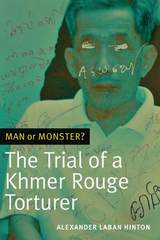 Man or Monster?: The Trial of a Khmer Rouge Torturer
Alexander Laban Hinton
Duke University Press, 2016 During the Khmer Rouge's brutal reign in Cambodia during the mid-to-late 1970s, a former math teacher named Duch served as the commandant of the S-21 security center, where as many as 20,000 victims were interrogated, tortured, and executed. In 2009 Duch stood trial for these crimes against humanity. While the prosecution painted Duch as evil, his defense lawyers claimed he simply followed orders. In Man or Monster? Alexander Hinton uses creative ethnographic writing, extensive fieldwork, hundreds of interviews, and his experience attending Duch's trial to create a nuanced analysis of Duch, the tribunal, the Khmer Rouge, and the after-effects of Cambodia's genocide. Interested in how a person becomes a torturer and executioner as well as the law's ability to grapple with crimes against humanity, Hinton adapts Hannah Arendt's notion of the "banality of evil" to consider how the potential for violence is embedded in the everyday ways people articulate meaning and comprehend the world. Man or Monster? provides novel ways to consider justice, terror, genocide, memory, truth, and humanity.
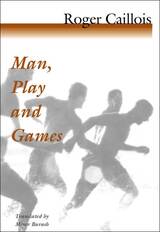 Man, Play and Games
Roger Caillois
University of Illinois Press, 1961 According to Roger Caillois, play is "an occasion of pure waste: waste of time, energy, ingenuity, skill, and often of money." In spite of this--or because of it--play constitutes an essential element of human social and spiritual development.
In this classic study, Caillois defines play as a free and voluntary activity that occurs in a pure space, isolated and protected from the rest of life. Play is uncertain, since the outcome may not be foreseen, and it is governed by rules that provide a level playing field for all participants. In its most basic form, play consists of finding a response to the opponent's action--or to the play situation--that is free within the limits set by the rules.
Caillois qualifies types of games-- according to whether competition, chance, simulation, or vertigo (being physically out of control) is dominant--and ways of playing, ranging from the unrestricted improvisation characteristic of children's play to the disciplined pursuit of solutions to gratuitously difficult puzzles. Caillois also examines the means by which games become part of daily life and ultimately contribute to various cultures their most characteristic customs and institutions.
Presented here in Meyer Barash's superb English translation, Man, Play and Games is a companion volume to Caillois's Man and the Sacred.
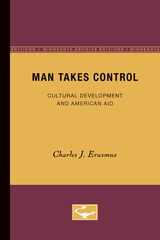 Man Takes Control: Cultural Development and American Aid
Charles Erasmus
University of Minnesota Press, 1961
Man Takes Control was first published in 1961.This is an inquiry into the causes and cultural behavior, the nature of its development, and problems of foreign aid in relation to cultural development. Professor Erasmus examines technical assistance programs in some of the underdeveloped areas of the world and relates the significance of such programs to a general concept of cultural change.Most of the examples are drawn from his own experiences. He presents a case study of cultural development in northwestern Mexico, where road and irrigation projects have created new opportunities for commercial expansion. The study is based on his observations in Sonora, Mexico, made while he was associated with the University of Illinois Cultural Change Project.Before presenting the case study, Professor Erasmus discusses his theories of cultural causality and cultural development. He projects and original theory of cultural causality with the causal components of cognition, motivation, and limitation. In a modification of Thorstein Veblen’s concepts of conspicuous consumption and invidious comparison, he offers a three-level view of cultural development which includes conspicuous giving, conspicuous ownership, and conspicuous production, with their corresponding types of invidious comparison.
 The Man That Got Away: The Life and Songs of Harold Arlen
Walter Rimler
University of Illinois Press, 2018 "Over the Rainbow," "Stormy Weather," and "One for My Baby" are just a few of Harold Arlen's well-loved compositions. Yet his name is hardly known--except to the musicians who venerate him. At a gathering of songwriters George Gershwin called him "the best of us." Irving Berlin agreed. Paul McCartney sent him a fan letter and became his publisher. Bob Dylan wrote of his fascination with Arlen's "bittersweet, lonely world." A cantor's son, Arlen believed his music was from a place outside himself, a place that also sent tragedy. When his wife became mentally ill and was institutionalized he turned to alcohol. It nearly killed him. But the beautiful songs kept coming: "Blues in the Night," "My Shining Hour," "Come Rain or Come Shine," and "The Man That Got Away." Walter Rimler drew on interviews with friends and associates of Arlen and on newly available archives to write this intimate portrait of a genius whose work is a pillar of the Great American Songbook.
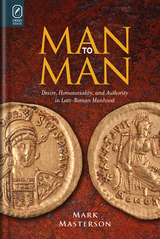 Man to Man: Desire, Homosociality, and Authority in Late-Roman Manhood
Mark Masterson
Ohio State University Press, 2014 In an analysis that promises to be controversial, Man to Man: Desire, Homosociality, and Authority in Late-Roman Manhood surveys the presence of same-sex desire between men in the later Roman empire. Most accounts of recent years have either noted that sexual desire between men was forbidden or they have ignored it. This book argues that desire between men was known and that it was a way to express friendship, patronage, solidarity, and other important relationships among elite males in late antiquity. The evocation of this desire and its possible attendant corporeal satisfactions made it a compelling metaphor for friendship. A man’s grandeur could also be portrayed metaphorically as sexual attractiveness, and the substantial status differences often seen in late antiquity could be ameliorated by a superior using amatory language to address an inferior.
At the same time, however, there was a marked ambivalence about same-sex desire and sexual behavior between men, and indeed same-sex sexual behavior was criminalized as it had never been before. While rejection and condemnation may seem to indicate a decisive distancing between authority and this desire and behavior, authority gained power from maintaining a relation to them. Demonstrating knowledge of the actual mechanics of sex between men suggested to a witness that there was nothing unknown to the authority making the demonstration: authority that knew of scandalous masculine sexual pleasure could project its power pretty much anywhere.
This startling dissonance between positive uses of same-sex desire between men and its criminalization in one and the same moment—a dissonance which recent discussions have been unable to address—requires further investigation, and this book supplies it.
The Man Verdi
Frank Walker
University of Chicago Press, 1982 In this classic biography of composer Giuseppe Verdi, Frank Walker reveals Verdi the man through his connections with the individuals who knew him best.
“Walker focuses on some of the more significant people in Verdi’s life and carefully scrutinizes his relationships with them. His wife, Giuseppina Strepponi; his student and amanuensis, Emanuele Muzio; the conductor who first fully understood Verdi’s mature art, Angelo Mariani; the great prima donna, Teresa Stolz; the incomparable librettist and friend of his old age, Arrigo Boito—each passes before our eyes in Walker’s meticulous reconstruction. As we learn more about them, we learn more about Verdi. We see him through the eyes of his closest friends, we watch his daily activities, his daily thoughts, his habits, his warmth, his domestic tyranny. The myth dissolves and a human being stands before us.”—Philip Gossett, from the introduction
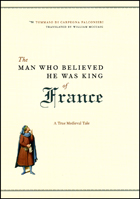 The Man Who Believed He Was King of France: A True Medieval Tale
Tommaso di Carpegna Falconieri
University of Chicago Press, 2008 Replete with shady merchants, scoundrels, hungry mercenaries, scheming nobles, and maneuvering cardinals, The Man Who Believed He Was King of France proves the adage that truth is often stranger than fiction—or at least as entertaining. The setting of this improbable but beguiling tale is 1354 and the Hundred Years’ War being waged for control of France. Seeing an opportunity for political and material gain, the demagogic dictator of Rome tells Giannino di Guccio that he is in fact the lost heir to Louis X, allegedly switched at birth with the son of a Tuscan merchant. Once convinced of his birthright, Giannino claims for himself the name Jean I, king of France, and sets out on a brave—if ultimately ruinous—quest that leads him across Europe to prove his identity. With the skill of a crime scene detective, Tommaso di Carpegna Falconieri digs up evidence in the historical record to follow the story of a life so incredible that it was long considered a literary invention of the Italian Renaissance. From Italy to Hungry, then through Germany and France, the would-be king’s unique combination of guile and earnestness seems to command the aid of lords and soldiers, the indulgence of inn-keepers and merchants, and the collusion of priests and rogues along the way. The apparent absurdity of the tale allows Carpegna Falconieri to analyze late-medieval society, exploring questions of essence and appearance, being and belief, at a time when the divine right of kings confronted the rise of mercantile culture. Giannino’s life represents a moment in which truth, lies, history, and memory combine to make us wonder where reality leaves off and fiction begins.
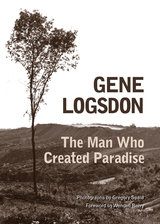 The Man Who Created Paradise: A Fable
Gene Logsdon
Ohio University Press, 2001 Gene Logsdon’s The Man Who Created Paradise is a message of hope at a time when the very concept of earth stewardship is under attack. The fable, inspired by a true story, tells how Wally Spero looked at one of the bleakest places in America—a raw and barren strip-mined landscape—and saw in it his escape from the drudgery of his factory job. He bought an old bulldozer and used the machine to carve patiently, acre by acre, a beautiful little farm out of a seemingly worthless wasteland. Wally’s story is a charming distillation of the themes that the late, beloved Gene Logsdon returned to again and again in his many books and hundreds of articles. Environmental restoration is the task of our time. The work of healing our land begins in our own backyards and farms, in our neighborhoods and our regions. Humans can turn the earth into a veritable paradise—if they really want to. Noted photographer Gregory Spaid retraced the trail that Logsdon traveled when he was inspired to write The Man Who Created Paradise. His photographs evoke the same yearning for wholeness, for ties to land and community, that infuses the fable’s poetic prose.
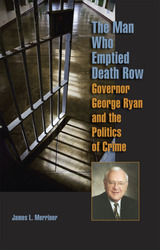 The Man Who Emptied Death Row: Governor George Ryan and the Politics of Crime
James L. Merriner
Southern Illinois University Press, 2008 George H. Ryan, Illinois governor from 1999 to 2003, became nationally known for two significant and very different reasons. The first governor in the United States to clear out his state’s death row and put a moratorium on the death penalty, he was also convicted and sent to prison on corruption charges. The Man Who Emptied Death Row: Governor George Ryan and the Politics of Crime details the career of a man who both enhanced and tarnished the image of the highest office in Illinois and examines the political history and culture that shaped him. Author James L. Merriner explores the two very different stories of George Ryan: the brave crusader against the death penalty and the petty crook. An extensive analysis of the official record, exclusive interviews, and previously undisclosed incidents in Ryan’s career expose why the governor pardoned or commuted the sentences of all 171 prisoners on Illinois’s death row before leaving office and how he later was convicted of eighteen counts of official corruption. This biography traces Ryan’s family history and the Illinois political climate that influenced his development as a politician. Although Ryan championed “good-government” initiatives—organ donations, tougher drunken-driving and lobbyist disclosure laws—he never overcame a reputation as a wheeler-dealer, notes Merriner. Merriner goes beyond Ryan’s life and career to explore the politics of crime, highlighting the successes and failures of the criminal justice system and suggesting how both white-collar fraud and violent crime shape politics. A fascinating story that reveals much about the way Illinois politics works, The Man Who Emptied Death Row will help determine how history will judge Illinois governor George Ryan.
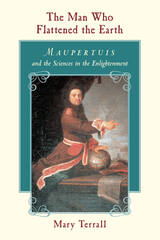 The Man Who Flattened the Earth: Maupertuis and the Sciences in the Enlightenment
Mary Terrall
University of Chicago Press, 2002 Self-styled adventurer, literary wit, philosopher, and statesman of science, Pierre-Louis Moreau de Maupertuis (1698-1759) stood at the center of Enlightenment science and culture. Offering an elegant and accessible portrait of this remarkable man, Mary Terrall uses the story of Maupertuis's life, self-fashioning, and scientific works to explore what it meant to do science and to be a man of science in eighteenth-century Europe. Beginning his scientific career as a mathematician in Paris, Maupertuis entered the public eye with a much-discussed expedition to Lapland, which confirmed Newton's calculation that the earth was flattened at the poles. He also made significant, and often intentionally controversial, contributions to physics, life science, navigation, astronomy, and metaphysics. Called to Berlin by Frederick the Great, Maupertuis moved to Prussia to preside over the Academy of Sciences there. Equally at home in salons, cafés, scientific academies, and royal courts, Maupertuis used his social connections and his printed works to enhance a carefully constructed reputation as both a man of letters and a man of science. His social and institutional affiliations, in turn, affected how Maupertuis formulated his ideas, how he presented them to his contemporaries, and the reactions they provoked. Terrall not only illuminates the life and work of a colorful and important Enlightenment figure, but also uses his story to delve into many wider issues, including the development of scientific institutions, the impact of print culture on science, and the interactions of science and government. Smart and highly readable, Maupertuis will appeal to anyone interested in eighteenth-century science and culture. “Terrall’s work is scholarship in the best sense. Her explanations of arcane 18th-century French physics, mathematics, astronomy, and biology are among the most lucid available in any language.”—Virginia Dawson , American Historical Review Winner of the 2003 Pfizer Award from the History of Science Society
The Man Who Found the Missing Link: Eugène Dubois and His Lifelong Quest to Prove Darwin Right
Pat Shipman
Harvard University Press Born eighteen months after the first Neanderthal skeleton was found and a year before Charles Darwin published The Origin of Species, Eugene Dubois vowed to discover a powerful truth in Darwin's deceptively simple ideas. There is a link, he declared, a link as yet unknown, between apes and Man.
It takes a brilliant writer to elucidate a brilliant mind, and Pat Shipman shines as never before. The Man Who Found the Missing Link is an irresistible tale of adventure, scientific daring, and a strange and enduring love--and it is true.
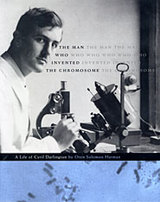 The Man Who Invented the Chromosome: A Life of Cyril Darlington
Oren Solomon Harman
Harvard University Press, 2004 Born by mistake, or connivance, to struggling parents in a small Lancashire cotton town in 1903, an uninspired Darlington inadvertently escaped the obscurity of farming life and rose instead, against all odds, to become within a few short years the world's greatest expert on chromosomes, and one of the most penetrating biological thinkers of the twentieth century. Harman follows Darlington's path from bleak prospects to world fame, showing how, within the most miniscule of worlds, he sought answers to the biggest questions--how species originate, how variation occurs, how Nature, both blind and foreboding, random and insightful, makes her way from deep past to unknown future. But Darlington did not stop there: Chromosomes held within their tiny confines untold, dark truths about man and his culture. This passionate conviction led the once famed Darlington down a path of rebuke, isolation, and finally obscurity.
As The Man Who Invented the Chromosome unfolds Darlington's forgotten tale--the Nazi atrocities, the Cold War, the crackpot Lysenko, the molecular revolution, eugenics, Civil Rights, the welfare state, the changing views of man's place in nature, biological determinism--all were interconnected. Just as Darlington's work provoked him to ask questions about the link between biology and culture, his life raises fundamental questions about the link between science and society.
 The Man Who Is and Is Not There: The Poetry and Prose of Robert Francis
Andrew Stambuk
University of Massachusetts Press, 2011 Robert Francis (1901–1987), the author of eight volumes of poetry, an autobiography, a book of fiction, essays on poetry, and a reminiscence of Robert Frost, lived for most of his career on the outskirts of Amherst, Massachusetts, devoting himself to Yankee simplicity and self-renunciation derived from his reading of Thoreau. His preference for solitude and disinclination to write about or promote himself account for the elusiveness of his persona in his prose and poetry.
This book charts how Francis developed and elaborated this persona through distanced self-portraits in prose and through poems that both reveal and conceal the self of the poet. Folded into the study are discussions of Francis's pastoralism, his affinities with Emerson and Thoreau, his experimentation with new poetic forms, his protest against the Vietnam War and environmental despoliation, his homoeroticism, and a comparison of his poetry with that of Robert Frost. The book also explores Francis's characteristic attitude, figured as "hovering," where his speaker is both subject and object, writing about himself while inhabiting the role of detached observer.
Complementing the emphasis on Francis's elusiveness, Andrew Stambuk offers readings of his poems attentive to aesthetic qualities that give them their particular reticence. Stambuk's sensitive evaluations underscore that Francis is a craftsman of intricate precisions whose work speaks to contemporary political and global concerns.
The Man Who Killed The Deer: A Novel of Pueblo Indian Life
Frank Waters
Ohio University Press, 1949 The story of Martiniano, The Man Who Killed the Deer, is a timeless story of Pueblo Indian sin and redemption, and of the conflict between Indian and white laws; written with a poetically charged beauty of style, a purity of conception, and a thorough understanding of Native American values.
The Man Who Loved Levittown
W. D. Wetherell
University of Pittsburgh Press, 1985 This book is characterized by narrative vitality and emotional range. In Wetherell’s stories a suburban retiree’s assumptions about the ethos of Long Island life are challenged and dismissed by a younger generation, a young English woman achieves miracles by dancing with wounded soldiers during World War II, a tennis-mad bachelor plays an interior game as real to him as an actual match, and a black drifter converts an Asian couple to his bleak vision of American life and finds strange kinship with them.
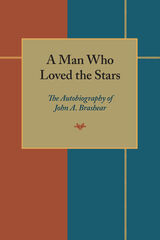 A Man Who Loved the Stars: The Autobiography of John A. Brashear
John A. Brashear
University of Pittsburgh Press, 1988 The inspiring story of a man whose avocation as a stargazer and vocation as a millwright led to his development of lenses, mirrors and other astronomical apparatus. John A. Brashear's technological advances were later employed by astronomers in the United States and Europe. Brashear also attracted the friendship and financial support of astronomer Samuel Lagley, railroad magnate William Thaw, Henry Clay Frick, and Andrew Carnegie, who gave him $20,000 for the construction of Allegheny Observatory in Pittsburgh. The inspiring story of a man whose avocation as a stargazer and vocation as a millwright led to his development of lenses, mirrors and other astronomical apparatus. John A. Brashear's technological advances were later employed by astronomers in the United States and Europe. Brashear also attracted the friendship and financial support of astronomer Samuel Lagley, railroad magnate William Thaw, Henry Clay Frick, and Andrew Carnegie, who gave him $20,000 for the construction of Allegheny Observatory in Pittsburgh.
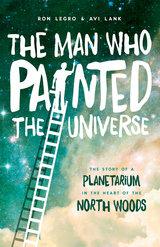 The Man Who Painted the Universe: The Story of a Planetarium in the Heart of the North Woods
Ron Legro
Wisconsin Historical Society Press, 2015 As a young boy Frank Kovac Jr. fell deeply in love with stargazing, painting glow-in-the-dark constellations on his bedroom wall and inviting friends to an observatory he built in his Chicago backyard. As he reached adulthood, Kovac did not let go of his childhood dreams of reaching the stars. He began scheming to bring the universe home. While working at a paper mill as a young man, Kovac tirelessly built a 22-foot rotating globe planetarium in the woods. Despite failures and collapses, the amateur astronomer singlehandedly built a North Woods treasure, painting more than 5,000 glowing stars—dot by dot in glowing paints. Today, Kovac and his unique planetarium take visitors to the stars every day.
The Man Who Painted the Universe: The Story of a Planetarium in the Heart of the North Woods introduces readers to the mild-mannered astronomy enthusiast whose creativity, ingenuity, fervor, and endurance realized a dream of galactic proportions. The story of this stargazer from Wisconsin’s North Woods so inspired two newspapermen, authors Ron Legro and Avi Lank, that they sought to document the story of the Kovac Planetarium for a new generation of stargazers and dreamers.
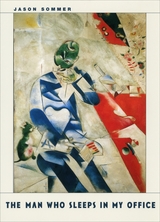 The Man Who Sleeps in My Office
Jason Sommer
University of Chicago Press, 2004 With grace and style, Jason Sommer considers how to live in the wake of history among those who are indelibly marked by it. On the surface a book of poems composed in the shadow of the Holocaust, The Man Who Sleeps in My Office offers more than a poetic chronicle of suffering and loss. Instead, Sommer—the son of a survivor—has discovered a delicate balance that allows him to be in and of history without succumbing to it. In these works, both the seen and the unseen—the failed or rejected vision—alter the seer, as the limit of one thing becomes the verge of something else. Whether about the Holocaust, the dog he'll never own, or love between a husband and wife or parent and child, these poems savor the mysterious instant when alternatives of vision unfold. While these moments may also conjure loss, the losses are made good, as when, in "Legion," someone forgets why he has walked into a room but salvages from the lapse not the purpose of the errand but a sense of the ultimate worth of a life. These finely crafted narrative poems tell the story of these unanticipated perceptions, when the ordinary opens to the very human story of failed understanding and quiet epiphany.
The Man Who Stayed Behind
Sidney Rittenberg and Amanda Bennett
Duke University Press, 2001 The Man Who Stayed Behind is the remarkable account of Sidney Rittenberg, an American who was sent to China by the U.S. military in the 1940s. A student activist and labor organizer who was fluent in Chinese, Rittenberg became caught up in the turbulence that engulfed China and remained there until the late 1970s. Even with access to China’s highest leaders as an American communist, however, he was twice imprisoned for a total of sixteen years.
Both a memoir and a documentary history of the Chinese revolution from 1949 through the Cultural Revolution, The Man Who Stayed Behind provides a human perspective on China’s efforts to build a new society. Critical of both his own mistakes and those of the Communist leadership, Rittenberg nevertheless gives an even-handed account of a country that is now free of internal war for the first time in a hundred years.
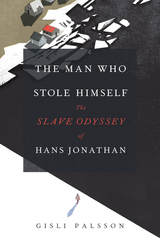 The Man Who Stole Himself: The Slave Odyssey of Hans Jonathan
Gisli Palsson
University of Chicago Press, 2016 The life story of Hans Jonathan, Iceland's first Black citizen.
The island nation of Iceland is known for many things—majestic landscapes, volcanic eruptions, distinctive seafood—but racial diversity is not one of them. So the little-known story of Hans Jonathan, a free Black man who lived and raised a family in early nineteenth-century Iceland, is improbable and compelling, the stuff of novels.
In The Man Who Stole Himself, Gisli Palsson lays out the story of Hans Jonathan (also known as Hans Jónatan) in stunning detail. Born into slavery in St. Croix in 1784, Hans was taken as a slave to Denmark, where he eventually enlisted in the navy and fought on behalf of the country in the 1801 Battle of Copenhagen. After the war, he declared himself a free man, believing that he was due freedom not only because of his patriotic service, but because while slavery remained legal in the colonies, it was outlawed in Denmark itself. He thus became the subject of one of the most notorious slavery cases in European history, which he lost. Then Hans ran away—never to be heard from in Denmark again, his fate unknown for more than two hundred years. It’s now known that Hans fled to Iceland, where he became a merchant and peasant farmer, married, and raised two children. Today, he has become something of an Icelandic icon, claimed as a proud and daring ancestor both there and among his descendants in America.
The Man Who Stole Himself brilliantly intertwines Hans Jonathan’s adventurous travels with a portrait of the Danish slave trade, legal arguments over slavery, and the state of nineteenth-century race relations in the Northern Atlantic world. Throughout the book, Palsson traces themes of imperial dreams, colonialism, human rights, and globalization, which all come together in the life of a single, remarkable man. Hans literally led a life like no other. His is the story of a man who had the temerity—the courage—to steal himself.
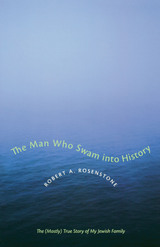 The Man Who Swam into History: The (Mostly) True Story of My Jewish Family
By Robert A. Rosenstone
University of Texas Press, 2005 The story begins with a grandfather who heroically escaped from Russia by swimming the Pruth River to Romania—or did he? Then there are stories of another grandfather who kept a lifelong mistress; grandmothers who were ignored except in the kitchen; migrations legal and illegal from Eastern Europe to Canada to California; racketeers on one side of the family and Communists on the other; and a West Coast adolescence in the McCarthy years. All of these (mostly true) stories form a Jewish family's history, a tale of dislocation and assimilation. But in the hands of award-winning historian Robert Rosenstone, they become much more. The fragments of memory so beautifully preserved in The Man Who Swam into History add unforgettable, human characters to the now familiar story of the Jewish diaspora in the twentieth century. This combination memoir/short story collection recounts the Rosenstone family's passage from Romania to America. Robert Rosenstone tells the story not as a single, linear narrative, but through "tales, sequences, windows, moments, and fragments resurrected from the lives of three generations in my two parental families, set in five countries on two continents over the period of almost a century." This more literary and personal approach allows Rosenstone's relatives to emerge as distinct personalities, voices who quarrel and gossip, share their dreams and fears, and maintain the ties of a loving, if eccentric, family. Among the genre of "coming to America" tales, The Man Who Swam into History is a work of unique vision, one that both records and reconstructs the past even as it continuously—and humorously—questions the truth of its own assertions.
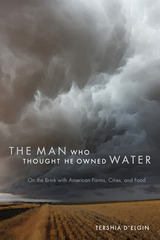 The Man Who Thought He Owned Water: On the Brink with American Farms, Cities, and Food
Tershia d'Elgin
University Press of Colorado, 2016 The Man Who Thought He Owned Water is author Tershia d’Elgin’s fresh take on the gravest challenge of our time—how to support urbanization without killing ourselves in the process. The gritty story of her family’s experience with water rights on its Colorado farm provides essential background about American farms, food, and water administration in the West in the context of growing cities and climate change. Enchanting and informative, The Man Who Thought He Owned Water is an appeal for urban-rural cooperation over water and resiliency.
When her father bought his farm—Big Bend Station—he also bought the ample water rights associated with the land and the South Platte River, confident that he had secured the necessary resources for a successful endeavor. Yet water immediately proved fickle, hard to defend, and sometimes dangerous. Eventually those rights were curtailed without compensation. Through her family’s story, d’Elgin dramatically frames the personal-scale implications of water competition, revealing how water deals, infrastructure, transport, and management create economic growth but also sever human connections to Earth’s most vital resource. She shows how water flows to cities at the expense of American-grown food, as rural land turns to desert, wildlife starves, the environment degrades, and climate change intensifies.
Depicting deep love, obsession, and breathtaking landscape, The Man Who Thought He Owned Water is an impassioned call to rebalance our relationship with water. It will be of great interest to anyone seeking to understand the complex forces affecting water resources, food supply, food security, and biodiversity in America.
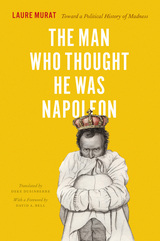 The Man Who Thought He Was Napoleon: Toward a Political History of Madness
Laure Murat
University of Chicago Press, 2014 The Man Who Thought He Was Napoleon is built around a bizarre historical event and an off-hand challenge. The event? In December 1840, nearly twenty years after his death, the remains of Napoleon were returned to Paris for burial—and the next day, the director of a Paris hospital for the insane admitted fourteen men who claimed to be Napoleon. The challenge, meanwhile, is the claim by great French psychiatrist Jean-Étienne-Dominique Esquirol (1772–1840) that he could recount the history of France through asylum registries.
From those two components, Laure Murat embarks on an exploration of the surprising relationship between history and madness. She uncovers countless stories of patients whose delusions seem to be rooted in the historical or political traumas of their time, like the watchmaker who believed he lived with a new head, his original having been removed at the guillotine. In the troubled wake of the Revolution, meanwhile, French physicians diagnosed a number of mental illnesses tied to current events, from “revolutionary neuroses” and “democratic disease” to the “ambitious monomania” of the Restoration. How, Murat asks, do history and psychiatry, the nation and the individual psyche, interface?
A fascinating history of psychiatry—but of a wholly new sort—The Man Who Thought He Was Napoleon offers the first sustained analysis of the intertwined discourses of madness, psychiatry, history, and political theory.
 The Man Who Would Marry Susan Sontag: And Other Intimate Literary Portraits of the Bohemian Era
Edward Field
University of Wisconsin Press, 2007 Long before Stonewall, young Air Force veteran Edward Field, fresh from combat in WWII, threw himself into New York’s literary bohemia, searching for fulfillment as a gay man and poet. In this vivid account of his avant-garde years in Greenwich Village and the bohemian outposts of Paris’s Left Bank and Tangier—where you could write poetry, be radical, and be openly gay—Field opens the closet door to reveal, as never been seen before, some of the most important writers of his time. Here are young, beautiful Susan Sontag sitting at the feet of her idol Alfred Chester, who shrewdly plotted to marry her; May Swenson and her two loves; Paul and Jane Bowles in their ambiguous marriage; Frank O’Hara in and out of bed; Fritz Peters, the anointed son of Gurdjieff; and James Baldwin, Isabel Miller (Patience and Sarah), Tobias Schneebaum, Robert Friend, and many others. With its intimate portraits, Field’s memoir brings back a forgotten era—postwar bohemia—bawdy, comical, romantic, sad, and heroic.
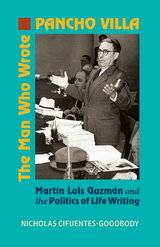 The Man Who Wrote Pancho Villa: Martin Luis Guzman and the Politics of Life Writing
Nicholas Cifuentes-Goodbody
Vanderbilt University Press, 2016 Martin Luis Guzman was many things throughout his career in twentieth-century Mexico: a soldier in Pancho Villa's revolutionary army, a journalist-in-exile, one of the most esteemed novelists and scholars of the revolutionary era, and an elder statesman and politician. In The Man Who Wrote Pancho Villa, we see the famous author as he really was: a careful craftsman of his own image and legacy. His five-volume biography of Villa propelled him to the heights of Mexican cultural life, and thus began his true life's work. Nicholas Cifuentes-Goodbody shapes this study of Guzman through the lens of "life writing" and uncovers a tireless effort by Guzman to shape his public image.
The Man Who Wrote Pancho Villa places Guzman's work in a biographical context, shedding light on the immediate motivations behind his writing in a given moment and the subsequent ways in which he rewrote or repackaged the material. Despite his efforts to establish a definitive reading of his life and literature, Guzman was unable to control that interpretation as audiences became less tolerant of the glaring omissions in his self-portrait.
 The Man Who Wrote the Perfect Novel: John Williams, Stoner, and the Writing Life
By Charles J. Shields
University of Texas Press, 2018 When Stoner was published in 1965, the novel sold only a couple of thousand copies before disappearing with hardly a trace. Yet John Williams’s quietly powerful tale of a Midwestern college professor, William Stoner, whose life becomes a parable of solitude and anguish eventually found an admiring audience in America and especially in Europe. The New York Times called Stoner “a perfect novel,” and a host of writers and critics, including Colum McCann, Julian Barnes, Bret Easton Ellis, Ian McEwan, Emma Straub, Ruth Rendell, C. P. Snow, and Irving Howe, praised its artistry. The New Yorker deemed it “a masterly portrait of a truly virtuous and dedicated man.” The Man Who Wrote the Perfect Novel traces the life of Stoner’s author, John Williams. Acclaimed biographer Charles J. Shields follows the whole arc of Williams’s life, which in many ways paralleled that of his titular character, from their shared working-class backgrounds to their undistinguished careers in the halls of academia. Shields vividly recounts Williams’s development as an author, whose other works include the novels Butcher’s Crossing and Augustus (for the latter, Williams shared the 1972 National Book Award). Shields also reveals the astonishing afterlife of Stoner, which garnered new fans with each American reissue, and then became a bestseller all over Europe after Dutch publisher Lebowski brought out a translation in 2013. Since then, Stoner has been published in twenty-one countries and has sold over a million copies.
The Man with a Shattered World: The History of a Brain Wound
A. R. Luria
Harvard University Press, 1987 Russian psychologist A. R. Luria presents a compelling portrait of a man’s heroic struggle to regain his mental faculties. A soldier named Zasetsky, wounded in the head at the battle of Smolensk in 1943, suddenly found himself in a frightening world: he could recall his childhood but not his recent past; half his field of vision had been destroyed; he had great difficulty speaking, reading, and writing.
Much of the book consists of excerpts from Zasetsky’s own diaries. Laboriously, he records his memories in order to reestablish his past and to affirm his existence as an intelligent being. Luria’s comments and interpolations provide a valuable distillation of the theory and techniques that guided all of his research. His “digressions” are excellent brief introductions to the topic of brain structure and its relation to higher mental functions.
The Man With Many Pens
Jonathan Wells
Four Way Books, 2015 The Man with Many Pens is about love—“a love that smells so much like blood”—and song—“a song that the oak leaves will not finish.” These poems examine how a single love or a single song contains multiple personalities and contradictory forces, tensions, and concordances.
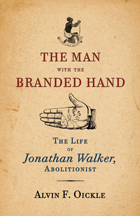 The Man with the Branded Hand: The Life of Jonathan Walker, Abolitionist
Alvin F. Oickle
Westholme Publishing, 2011 Captured While Attempting to Smuggle Slaves to Freedom in 1844, the Only Man Branded in a Courtroom by a United States Marshal
Sailing around the Florida Keys in 1844, forty-five-year-old Jonathan Walker had a price on his head. On board the small boat he had built that winter in Alabama were seven fugitives from slavery. The Cape Cod sailor and abolitionist was wanted in Pensacola, Florida, for his crime: stealing slaves. The slaves’ owners had posted $100 each as reward money for their property and $1,000 for Walker’s apprehension. Only a day’s sail from their goal of freedom in British-controlled Bahamas, Walker and the slaves were stopped and seized by bounty hunters and taken to a Key West court. Ordered back to Pensacola for trial, Walker ended up spending a year in jail. He was fined and sentenced to stand in the pillory; in addition, he was to suffer a unique punishment in American history: while a packed courtroom watched, a United States marshal was ordered to use a hot branding iron to burn the letters SS, for “slave stealer,” into Walker’s right hand. Walker survived his ordeal, spending much of his incarceration in isolation. Once released, he remained active in the antislavery movement even while he and his devoted wife Jane raised their nine children. His attempt to help form a new colony in Mexico for runaway American slaves also led to punishing experiences for Walker and one of his sons. Living later with his family in Plymouth, Massachusetts, in the years before the Civil War, Walker made room in his crowded house to shelter runaway slaves along the Underground Railroad. He participated in abolitionist lecture tours across the North where he would be urged to reveal his branded hand—made famous by John Greenleaf Whittier’s poem “The Branded Hand”—to astonished audiences. Too old to enlist in the Civil War, Walker instead headed to Virginia in the war’s final year to help educate African Americans fleeing Confederate forces. In The Man With the Branded Hand: The Life of Jonathan Walker, Abolitionist, distinguished journalist Alvin F. Oickle relates this entire remarkable story of a life devoted to the supposition that “all men are created equal.”
The Man with the Getaway Face: A Parker Novel
Richard Stark
University of Chicago Press, 1963 In New York there was a contract on his life. In Nebraska there was an unscrupulous plastic surgeon guarded by a punch-drunk fighter. And somewhere in New Jersey there was an armored car stuffed with money. In the middle of it all was Parker.
Parker goes under the knife in The Man with the Getaway Face, changing his face to escape the mob and a contract on his life. Along the way he scores his biggest heist yet, but there’s a catch—a beautiful, dangerous catch who goes by the name Alma.
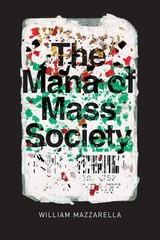 The Mana of Mass Society
William Mazzarella
University of Chicago Press, 2017
We often invoke the “magic” of mass media to describe seductive advertising or charismatic politicians. In The Mana of Mass Society, William Mazzarella asks what happens to social theory if we take that idea seriously. How would it change our understanding of publicity, propaganda, love, and power?
Mazzarella reconsiders the concept of “mana,” which served in early anthropology as a troubled bridge between “primitive” ritual and the fascination of mass media. Thinking about mana, Mazzarella shows, means rethinking some of our most fundamental questions: What powers authority? What in us responds to it? Is the mana that animates an Aboriginal ritual the same as the mana that energizes a revolutionary crowd, a consumer public, or an art encounter? At the intersection of anthropology and critical theory, The Mana of Mass Society brings recent conversations around affect, sovereignty, and emergence into creative contact with classic debates on religion, charisma, ideology, and aesthetics.
 The Manageable Cold: Poems
Timothy McBride
Northwestern University Press, 2010 Displaying a confidence and maturity rarely found in a first collection, Timothy McBride’s The Manageable Cold is a record of a sustained encounter with some of the most vital aspects of a life—childhood, language, romance, the body, the natural world.
The Manageable Cold showcases McBride’s mastery of a wide range of forms and subjects. Whether his attention is focused on boxing, jazz, or contranyms, McBride breathes new life into the sonnet and the villanelle and handles blank verse with the utmost ease. The combination of traditional techniques and McBride’s thoroughly modern sensibility gives rise to poems that seem simultaneously utterly fresh and immemorially old, calling to mind the rigorously embodied works of Robert Frost, Howard Nemerov, and Mary Oliver. Timothy McBride is a science writer and editor. His poems have appeared in Shenandoah, Seneca Review, and Poetry Northwest, among other publications. The Manageable Cold is his first book of poetry.
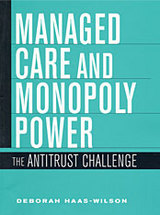 Managed Care and Monopoly Power: The Antitrust Challenge
Deborah Haas-Wilson
Harvard University Press, 2003 As millions of Americans are aware, health care costs continue to increase rapidly. Much of this increase is due to the development of new life-sustaining drugs and procedures, but part of it is due to the increased monopoly power of physicians, insurance companies, and hospitals, as the health care sector undergoes reorganization and consolidation. There are two tools to limit the growth of monopoly power: government regulation and antitrust policy. In this timely book, Deborah Haas-Wilson argues that enforcement of the antitrust laws is the tool of choice in most cases.
The antitrust laws, when wisely enforced, permit markets to work competitively and therefore efficiently. Competitive markets foster low prices and high quality. Applying antitrust tools wisely, however, is a tricky business, and Haas-Wilson carefully explains how it can be done. Focusing on the economic concepts necessary to the enforcement of the antitrust laws in health care markets, Haas-Wilson provides a useful roadmap for guiding the future of these markets.
 The Managed Care Blues and How to Cure Them
Walter A. Zelman and Robert A. Berenson
Georgetown University Press, 1998 Shattering the myths about what’s wrong with managed health care, this penetrating introduction to managed care explains its origins and identifies its real achievements and shortcomings. Walter A. Zelman and Robert A. Berenson argue that many criticisms of managed care tend to idealize the costly and fragmented insurance system it supplanted, without pinpointing the true inadequacies of today’s managed care. In addition to providing reasoned answers to the most alarmist critiques of managed care, the authors maintain that it has not fulfilled its potential to improve the overall quality of care. The authors propose thirteen concrete recommendations for raising quality in managed care programs, ranging from enacting additional legal protections and increased disclosure to putting the purchasing power in the hands of those who care most about quality — individuals, rather than employers. With practical solutions for making managed care better, The Managed Care Blues and How to Cure Them is a bold call for greater consumer protection, knowledge, and power in the health care arena.
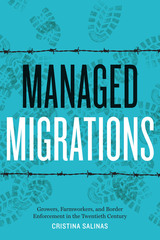 Managed Migrations: Growers, Farmworkers, and Border Enforcement in the Twentieth Century
By Cristina Salinas
University of Texas Press, 2018 2020 National Association for Chicana and Chicano Studies (NACCS) Book Award Winner
Honorable Mention, Ramirez Family Award for Most Significant Scholarly Book, Texas Institute of Letters, 2019 Managed Migrations examines the concurrent development of a border agricultural industry and changing methods of border enforcement in the Rio Grande Valley of Texas during the past century.
Needed at one moment, scorned at others, Mexican agricultural workers have moved back and forth across the US–Mexico border for the past century. In South Texas, Anglo growers’ dreams of creating a modern agricultural empire depended on continuous access to Mexican workers. While this access was officially regulated by immigration laws and policy promulgated in Washington, DC, in practice the migration of Mexican labor involved daily, on-the-ground negotiations among growers, workers, and the US Border Patrol. In a very real sense, these groups set the parameters of border enforcement policy. Managed Migrations examines the relationship between immigration laws and policy and the agricultural labor relations of growers and workers in South Texas and El Paso during the 1940s and 1950s. Cristina Salinas argues that immigration law was mainly enacted not in embassies or the halls of Congress but on the ground, as a result of daily decisions by the Border Patrol that growers and workers negotiated and contested. She describes how the INS devised techniques to facilitate high-volume yearly deportations and shows how the agency used these enforcement practices to manage the seasonal agricultural labor migration across the border. Her pioneering research reveals the great extent to which immigration policy was made at the local level, as well as the agency of Mexican farmworkers who managed to maintain their mobility and kinship networks despite the constraints of grower paternalism and enforcement actions by the Border Patrol.
 Management Basics for Information Professionals
G. Edward Evans
American Library Association, 2020 The recipient of rave reviews from far and wide (Journal of Hospital Librarianship deemed it “a librarian’s dream … very forward-thinking”), since its initial publication this text has served as an essential resource for both LIS students and practitioners. The new fourth edition offers an updated, comprehensive examination of the myriad of basic skills effective library managers must exercise throughout their careers. Throughout, Evans and new co-author Greenwell pay close attention to management in "new normal" straitened economic conditions and the pervasive impact of technology on a library manager’s role. This book’s coverage includes - a new focus on how being in the public/nonprofit sector influences the application of management basics such as planning, accountability, trust and delegation, decision making, principles of effective organizational communication, fostering change and innovation, quality control, and marketing;
- the managerial environment, organizational skill sets, the importance of a people-friendly organization, and legal issues;
- key points on leadership, team-building, and human resource management;
- budget, resource, and technology management;
- management ethics, with a lengthy discussion of why ethics matter; and
- tips for planning a library career, with a look at the work/life debate.
This book, to quote Australian Library Journal, is “a recommended text for library science students, but is also an excellent source of information for career librarians wanting to refresh their knowledge of library management in a fast-moving information services environment.”
 Management Guide to Condition Monitoring in Manufacture
A. Davies
The Institution of Engineering and Technology, 1990 This book is simply intended to be a guide to the subject, to enable those wishing to implement Condition Monitoring to be more aware of the nature and benefits of its practice and techniques, and so help them to get started. In fact, to date everything suggests that British industry is somewhat unaware of the potential advantages that Condition Monitoring can bring to sharpen the competitive edge - and that many producers are quite uniformed even of the method and application of Condition Monitoring itself, as an aid to reliable production and for maintaining the condition of factories at peak performance. To be totally effective in a modern manufacturing application, Condition Monitoring should be considered firstly at the design stage; as 'built-in', and then as part of an on-going Condition Based Maintenance policy. It is essentially plant Predictive Maintenance by 'health checks', conducted throughout the equipment life-cycle. So as such, this guide is deliberately not exhaustive in its coverage, but highlights the main ingredients, the various aspects being simply expressed and supported by additional reading and where to get help if desired.
A Management Guide to Logistics Engineering
K. Beal
The Institution of Engineering and Technology, 1989 This guide will prove a great help to businesses in providing the pratical advice that will enable them to master the art of logistics so it can be used to their best business advantage.
Management of Smallpox Eradication in India
Lawrence B. Brilliant
University of Michigan Press, 2025 Doctor Lawrence Brilliant and Doctor Isao Arita, Chief, Smallpox Eradication Programme, World Health Organization, Geneva, Switzerland, visited West Bengal during the autumn of 1973 in order to initiate the first trial of the smallpox eradication program, namely, a statewide search for hidden cases in a population of sixty million. Eighteen months of intensive work produced a final result of the recording of the last smallpox case in India; the date of onset of rash was May 24, 1975. No more cases have been detected.
The Management of the Matobo Hills in Zimbabwe: Perceptions of the Indigenous Communities on Their Involvement and Use of Traditional Conservation Practices
Simon Makuvaza
Leiden University Press, 2017 Since 1992, when the World Heritage Committee established its category of “cultural landscapes,” scholarly debates have ensued as to how they could best be managed. One approach, which appears to have gained significance over the past two decades, considers using traditional conservation practices in addition to engaging local indigenous communities in the stewardship of these exemplary sites. Based on the perspectives of the indigenous people of the Matobo Hills, this investigation studies the extent to which both traditional conservation practices and local involvement can be germane to the administration of World Heritage Cultural Landscapes.
Managerial Capitalism: Ownership, Management, and the Coming New Mode of Production
Gérard Duménil and Dominique Lévy
Pluto Press, 2018 Marxist analysis has traditionally been built on a two-class framework: workers and capitalists. With Managerial Capitalism, Gerard Duménil and Dominique Lévy mount a powerful argument that such a framework is outdated—we are in fact amid a transition to a new mode of production, one that is fundamentally shaped by a third, intermediary class: managerialism.
Drawing examples from the United States and Europe, the authors offer a historically rooted interpretation of major current economic and political trends. Without eschewing Marx’s theory of history and political economy, they update it to take account of the changes underway in class patterns and relationships to production. The result is a robust new Marxism for the present and the future.
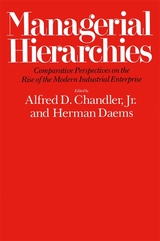 Managerial Hierarchies: Comparative Perspectives on the Rise of the Modern Industrial Enterprise
Alfred D. Chandler Jr.
Harvard University Press, 1980 The concept of the “visible hand” in big business enterprise, so persuasively and brilliantly argued in Alfred D. Chandler, Jr.’s prize-winning The Visible Hand: The Managerial Revolution in American Business, is tested and extended in this book. These essays show that the growth and complexity of managerial hierarchies (“visible hands”) in large business firms are central to the organization of modern industrial activity. Leading American and European historians retrace and compare the historical evolution of the contemporary giant managerial hierarchies in the United States, Britain, Germany, and France.
The first group of essays—by Chandler, Leslie Hannah, Jürgen Kocka, and Maurice Lévy-Leboyer—explores the rise of modern industrial enterprise in the West. They suggest the mechanisms and causes of the shift from the invisible hand of market coordination to the visible hand of managerial hierarchies, and attempt to pinpoint cultural and economic reasons for the persistence of transitional forms of organization in Europe. Other essays—by Morton Keller and Oliver E. Williamson—describe the legal and regulatory responses to the rise of big business and the implications of the history of the managerial revolution for students of economic development and industrial organization. The final essay, by Herman Daems, provides an overall analysis of the reasons managerial hierarchies replaced market mechanisms and agreements among firms as devices for coordination and the allocation of resources in advanced market economies.
This fresh study of the managerial revolution presents recent theoretical reflections in institutional economics and industrial organization in the light of new historical findings.
Managerial Psychology: Managing Behavior in Organizations
Harold J. Leavitt and Homa Bahrami
University of Chicago Press, 1988 The overall structure of this edition is the same as in the past. The book moves from the smaller to the larger. We start with the individual as the focal unit, move to two-person relationships, and onward to issues of leadership, power, small groups, and whole organizations.This edition focuses more than ever on the managing process—on whole organizations and on managing relationships with other organizations. To underline that emphasis, we have included a new section called 'The Manager's Job.' That section deals with what managers do, how they do it, why they do it, and how they should do it.
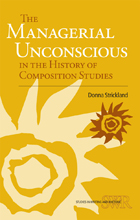 The Managerial Unconscious in the History of Composition Studies
Donna Strickland
Southern Illinois University Press, 2011 In this pointed appraisal of composition studies, Donna Strickland contends the rise of writing program administration is crucial to understanding the history of the field. Noting existing histories of composition studies that offer little to no exploration of administration, Strickland argues the field suffers from a “managerial unconscious” that ignores or denies the dependence of the teaching of writing on administrative structures.
The Managerial Unconscious in the History of Composition Studies is the first book to address the history of composition studies as a profession rather than focusing on its pedagogical theories and systems. Strickland questions why writing and the teaching of writing have been the major areas of scholarly inquiry in the field when specialists often work primarily as writing program administrators, not teachers.
Strickland traces the emergence of writing programs in the early twentieth century, the founding of two professional organizations by and for writing program administrators, and the managerial overtones of the “social turn” of the field during the 1990s. She illustrates how these managerial imperatives not only have provided much of the impetus for the growth of composition studies over the past three decades but also have contributed to the stratified workplaces and managed writing practices the field’s pedagogical research often decries.
The Managerial Unconscious in the History of Composition Studies makes the case that administrative work should not be separated from intellectual work, calling attention to the interplay between these two kinds of work in academia at large and to the pronounced hierarchies of contingent faculty and tenure-track administrators endemic to college writing programs. The result is a reasoned plea for an alternative understanding of the very mission of the field itself.
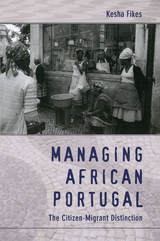 Managing African Portugal: The Citizen-Migrant Distinction
Kesha Fikes
Duke University Press, 2009 In Managing African Portugal, Kesha Fikes shows how the final integration of Portugal’s economic institutions into the European Union (EU) in the late 1990s changed everyday encounters between African migrants and Portuguese citizens. This economic transition is examined through transformations in ideologies of difference enacted in workspaces in Lisbon between the mid-1990s and the early 2000s. Fikes evaluates shifts in racial discourse and considers how both antiracism and racism instantiate proof of Portugal’s European “conversion” and modernization. The ethnographic focus is a former undocumented fish market that at one time employed both Portuguese and Cape Verdean women. Both groups eventually sought work in low-wage professions as maids, nannies, and restaurant-kitchen help. The visibility of poor Portuguese women as domestics was thought to undermine the appearance of Portuguese modernity; by contrast, the association of poor African women with domestic work confirmed it. Fikes argues that we can better understand how Portugal interpreted its economic absorption into the EU by attending to the different directions in which working-poor Portuguese and Cape Verdean women were routed in the mid-1990s and by observing the character of the new work relationships that developed among them. In Managing African Portugal, Fikes pushes for a study of migrant phenomena that considers not only how the enactment of citizenship by the citizen manages the migrant, but also how citizens are simultaneously governed through their uptake and assumption of new EU citizen roles.
Managing As If Faith Mattered: Christian Social Principles in the Modern Organization
Helen J. Alford, O.P., and Michael J. Naughton
University of Notre Dame Press, 2001 Managing As If Faith Mattered challenges the often-held double standard of private and public moralities. Authors Helen Alford and Michael Naughton bridge the fault line between work and faith by engaging current management issues with Christian ethics. Recovering a rich social tradition found within Christianity, the authors connect ideas such as the common good, virtue, and social principles, with concrete management issues such as job design, just wages, corporate ownership, marketing communication, and product development. In their hands, economic and social challenges become opportunities for managers to integrate their beliefs with their working environment and make decisions based on the tenets of Catholic social tradition.
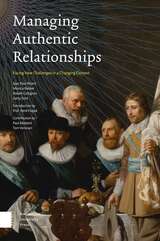 Managing Authentic Relationships: Facing New Challenges in a Changing Context
Jean Paul Wijers
Amsterdam University Press, 2019 In an increasingly connected world, Strategic Relationship Management is a vital capability for successful organizations. The book Managing Authentic Relationships; Facing New Challenges in a Changing Context focuses on building and managing a strong network and reciprocal relationships for the entire organization by implementing a professional relationship management approach at strategic, tactical and operational level.
Professional relationship management makes valuable and measurable contributions to the strategic goals of an organization by: Expanding the organization's strategy to a Relationship Management Strategy; Efficiently managing relationships and correctly mapping stakeholders; Embedding clear responsibility for relationship management throughout the organization; Measuring results and calculating the Return-on-Relationship; Developing strong networking skills and networkers who are able to act as eyes and ears for the organization; Organizing effective networking activities with measurable results.
This book also offers a holistic view. Managing authentic relationships requires a shared understanding of what relationships are. It is impossible to develop successful relationship management without authentic relationships based on trust and reciprocity.
Managing Chronicity in Unequal States: Ethnographic Perspectives on Caring
Edited by Laura Montesi and Melania Calestani
University College London, 2021 Surveys how patients with chronic conditions navigate unequal healthcare systems around the world.
Managing Chronicity in Unequal States offers a global survey of how people experience chronic conditions—from Alzheimer’s patients institutionalized in the United Kingdom to homeless people with psychiatric disorders in India. Contributors explore how communities navigate stratified healthcare systems whose unspoken attitudes toward human worth negatively affect their wellbeing. Whether the state intrudes into their intimate lives or abandons them to a market-driven runaround, the authors find that people with chronic conditions must negotiate (inter)dependencies in both professional and personal relationships primarily defined by inequality.
 Managing Complexity in Software Engineering
R.J. Mitchell
The Institution of Engineering and Technology, 1990 Software engineering products are becoming ever more complex, because software is being used in the solution of more technically difficult problems and because the size of software projects continues to grow. A key question for software engineers is how to cope with this complexity. There is no single answer, and software engineers must attack the problem from a number of perspectives. A technical perspective reveals new paradigms for system development, including two paradigms that show particular promise: object-oriented design and formal methods. A management perspective recognises that good project management is vital to the success of a complex project. The scale of modern projects makes it essential to use automated support, so software engineers must also look at how to manage complexity from an automation perspective. Automated support can come in the form of discrete tools for particular tasks, or a packaged set of tools in a support environment.
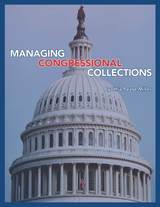 Managing Congressional Collections
Cynthia Pease Miller
Society of American Archivists, 2008 As diverse and rich as the American demographic is in their contents, the personal papers of members of Congress have tremendous and often untapped historic value in documenting each members district or state and its relationship to the federal government. Yet congressional collections challenge archivists and collecting institutions with every conceivable management problem associated with twentieth- and twenty-first-century records. From soliciting the collection and working with the member's office through detailed processing guidelines to planning effective outreach activities, each chapter of this manual includes the best practices for managing these unwieldy collections.
A project of the Congressional Papers Roundtable of the Society of American Archivists and funded by a grant from the National Historical Publications and Records Commission, Managing Congressional Collections serves the needs of administrators and archivists who work with these specialized collections.
Managing Contracted Services in the Nonprofit Agency: Administrative, Ethical, and Political Issues
Susan R. Bernstein, foreword by Roger A. Lohmann
Temple University Press, 1991 Through interviews conducted with nonprofit agency managers in the New York City metropolitan area, Susan Bernstein vividly describes their experiences with "contracting out," the principal way that the "reluctant" American welfare state has of providing public services through the private sector. The agency administrators look upon this as a nightmarish game and their stories illuminate how welfare state mechanisms work in practice as well as the tangled nature of bureaucracies Bernstein illustrates and analyzes these administrators’ strategies for managing the administrative, ethical, and political issues of contracted services. Managing Contracted Services is one of the first books to examine how administrators manage contracted services in a bureaucratic and political environment.
 Managing Costume Collections: An Essential Primer
Louise Coffey-Webb
Texas Tech University Press, 2016 Managing Costume Collections offers systematic approaches to organization, accessibility, record keeping, safety, and a host of other stewardship concerns related to managing costume collections of every type. Conceived to address needs long identified by the Costume Society of America, this guide is written for a broad spectrum of collection managers at museums, historical societies and houses, university theaters and study collections, and company archives, as well as for vintage dealers, private collectors, and living history performers.
Drawing on the wisdom of many disciplines, Coffey-Webb takes a holistic approach to problem-solving, explaining appropriate procedures and the reasons behind them, to arm collection managers, specialists and nonspecialists alike, with sufficient tools to make informed decisions on their own. She also offers alternative solutions to the recommended guidelines.
Although there are books on costume conservation, there is a paucity of available material on costume-collection management. Managing Costume Collections is the first work in collection management to address a wide audience, from general to academic and hobbyist to professional, interested specifically in costume.
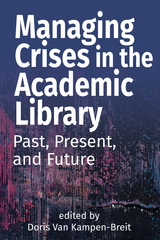 Managing Crises in the Academic Library: Past, Present, and Future
Doris Van Kampen-Breit
Association of College & Research Libraries, 2023 When a crisis occurs, it is the employees who determine an organization’s resiliency and effectiveness. It is their response, ability to plan for contingencies, and capacity for creating solutions that means the difference between organizational success and failure. In 29 chapters from authors in all institution types and sizes, Managing Crises in the Academic Library can help library workers learn from the crises of the past and prepare for the next unexpected event. Chapters cover lessons from the COVID-19 pandemic, perpetual budget uncertainty, dealing with downsizing, merging departments, mold mitigation, and mental health issues, but also offer strategies applicable during any crisis, including: - Responsive decision-making in academic library collections
- Managing stakeholder expectations
- Effective communication strategies
- Continuity of operations planning
- Utilizing library storage facilities
- Documentation and cross-training
- Mediating student technology needs
- Setting boundaries
Chapters include workflow charts, bibliographies, and concrete strategies that can be easily adopted into your crisis planning. Libraries and library workers are deeply sustaining lifelines for many students and faculty. Managing Crises in the Academic Library collects stories that demonstrate the tenacity, creativity, and ingenuity of academic library workers as they maintain this vital community lifeline and offers actionable ideas and approaches for planning for and sustaining the resources, services, and people in the library during difficult times.
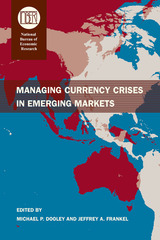 Managing Currency Crises in Emerging Markets
Edited by Michael P. Dooley and Jeffrey A. Frankel
University of Chicago Press, 2003 The management of financial crises in emerging markets is a vital and high-stakes challenge in an increasingly global economy. For this reason, it's also a highly contentious issue in today's public policy circles. In this book, leading economists-many of whom have also participated in policy debates on these issues-consider how best to reduce the frequency and cost of such crises.
The contributions here explore the management process from the beginning of a crisis to the long-term effects of the techniques used to minimize it. The first three chapters focus on the earliest responses and the immediate defense of a currency under attack, exploring whether unnecessary damage to economies can be avoided by adopting the right response within the first few days of a financial crisis. Next, contributors examine the adjustment programs that follow, considering how to design these programs so that they shorten the recovery phase, encourage economic growth, and minimize the probability of future difficulties. Finally, the last four papers analyze the actual effects of adjustment programs, asking whether they accomplish what they are designed to do-and whether, as many critics assert, they impose disproportionate costs on the poorest members of society.
Recent high-profile currency crises have proven not only how harmful they can be to neighboring economies and trading partners, but also how important policy responses can be in determining their duration and severity. Economists and policymakers will welcome the insightful evaluations in this important volume, and those of its companion, Sebastian Edwards and Jeffrey A. Frankel's Preventing Currency Crises in Emerging Markets.
 Managing Data for Patron Privacy: Comprehensive Strategies for Libraries
Kristin Briney and Becky Yoose
American Library Association, 2022 Libraries are not exempt from the financial costs of data breaches or leaks, no matter the size. Whether from a library worker unwittingly sharing a patron’s address with a perpetrator of domestic violence to leaving sensitive patron data unprotected, patrons can also pay a hefty price when libraries fail to manage patron data securely and ethically. In this guide, readers will learn concrete action steps for putting the ethical management of data into practice, following two common public and academic library cumulative case studies. The authors explore such key topics as - succinct summaries of major U.S. laws and other regulations and standards governing patron data management;
- information security practices to protect patrons and libraries from common threats;
- how to navigate barriers in organizational culture when implementing data privacy measures;
- sources for publicly available, customizable privacy training material for library workers;
- the data life cycle from planning and collecting to disposal;
- how to conduct a data inventory;
- understanding the associated privacy risks of different types of library data;
- why the current popular model of library assessment can become a huge privacy invasion;
- addressing key topics while keeping your privacy policy clear and understandable to patrons; and
- data privacy and security provisions to look for in vendor contracts.
 Managing Disaster: Strategies and Policy Perspectives
Louise K. Comfort
Duke University Press, 1988 This book reflects an important shift in society's definition of disaster. For centuries catastrophic events have been considered "acts of God" and therefore uncontrollable by definition. Managing Disaster is international in scope, covering such natural and man-made calamities as tornadoes in western Pennsylvania, earthquakes in Peru, flooding in the Netherlands, and toxic waste disasters. Centers for hazard studies have only recently examined the interrelated aspects of disastrous events and recognized the interaction between natural hazards and human systems. As society attempts to acquire the information and develop the skills to reduce the risks and damage from disaster, an increasingly professional public service is reconsidering its strategies and policy direction. Managing Disaster addresses this problem and the need for a new approach to teaching this subject at the university level. Twenty-three professionals and scholars in public policy and administration—rom universities, government, and the private sector—examine the basic issues confronting managers and public agencies in the face of disaster.
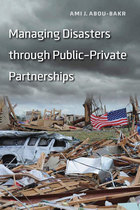 Managing Disasters through Public–Private Partnerships
Ami J. Abou-bakr
Georgetown University Press, 2013 The terrorist attacks of September 11, 2001, and Hurricane Katrina in August 2005, generated a great deal of discussion in public policy and disaster management circles about the importance of increasing national resilience to rebound from catastrophic events. Since the majority of physical and virtual networks that the United States relies upon are owned and operated by the private sector, a consensus has emerged that public-private partnerships (PPPs) are a crucial aspect of an effective resilience strategy. Significant barriers to cooperation persist, however, despite acknowledgment that public–private collaboration for managing disasters would be mutually beneficial. Managing Disasters through Public–Private Partnerships constitutes the first in-depth exploration of PPPs as tools of disaster mitigation, preparedness, response, and resilience in the United States. The author assesses the viability of PPPs at the federal level and explains why attempts to develop these partnerships have largely fallen short. The book assesses the recent history and current state of PPPs in the United States, with particular emphasis on the lessons of 9/11 and Katrina, and discusses two of the most significant PPPs in US history, the Federal Reserve System and the War Industries Board from World War I. The author develops two original frameworks to compare different kinds of PPPs and analyzes the critical factors that make them successes or failures, pointing toward ways to improve collaboration in the future. This book should be of interest to researchers and students in public policy, public administration, disaster management, infrastructure protection, and security; practitioners who work on public–private partnerships; and corporate as well as government emergency management professionals and specialists.
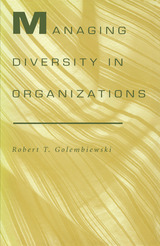 Managing Diversity in Organizations
Robert T. Golembiewski
University of Alabama Press, 1995 Managing Diversity in Organizations focuses on a key issue that organizations are facing—diversity. It is here, and it is growing. The only question now is how well we deal with diversity, especially in organizational contexts.
Golembiewski identifies the many forces and factors propelling us into the age of diversity in organizations—ethical, political, philosophic, demographic, and so on—and details the historical and contemporary approaches. Most practice has focused on a "level playing field" or equal opportunity and "tilting the playing field" or equal outcomes. This volume focuses on diversity as a strategic device rather than as a nicety rooted in behavioral and organizational research. Managing diversity successfully in organizations requires a thorough understanding of management infrastructure that is consistent with diversity--especially structures of work, policies, and procedures that institutionalize and build diversity.
 Managing Energy Use in Modern Buildings: Case Studies in Conservation Practice
Bernard Flaman
J. Paul Getty Trust, The, 2021 This timely volume brings together case studies that address the urgent need to manage energy use and improve thermal comfort in modern buildings while preserving their historic significance and character.
This collection of ten case studies addresses the issues surrounding the improvement of energy consumption and thermal comfort in modern buildings built between 1928 and 1969 and offers valuable lessons for other structures facing similar issues. These buildings, international in scope and diverse in type, style, and size, range from the Shulman House, a small residence in Los Angeles, to the TD Bank Tower, a skyscraper complex in Toronto, and from the Calouste Gulbenkian Foundation, a cultural venue in Lisbon, to the Van Nelle Factory in Rotterdam, now an office building. Showing ingenuity and sensitivity, the case studies consider improvements to such systems as heating, cooling, lighting, ventilation, and controls. They provide examples that demonstrate best practices in conservation and show ways to reduce carbon footprints, minimize impacts to historic materials and features, and introduce renewable energy sources, in compliance with energy codes and green-building rating systems.
The Conserving Modern Heritage series, launched in 2019, is written by architects, engineers, conservators, scholars, and allied professionals. The books in this series provide well-vetted case studies that address the challenges of conserving twentieth-century heritage.
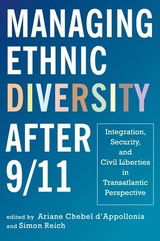 Managing Ethnic Diversity after 9/11: Integration, Security, and Civil Liberties in Transatlantic Perspective
Chebel d'Appollonia, Ariane
Rutgers University Press, 2010 America's approach to terrorism has focused on traditional national security methods, under the assumption that terrorism's roots are foreign and the solution to greater security lies in conventional practices. Europe offers a different model, with its response to internal terrorism relying on police procedures.
Managing Ethnic Diversity after 9/11 compares these two strategies and considers that both may have engendered greater radicalization--and a greater chance of home-grown terrorism. Essays address how transatlantic countries, including the United Kingdom, the United States, France, Germany, Spain, Italy, and the Netherlands have integrated ethnic minorities, especially Arabs and Muslims, since 9/11. Discussing the "securitization of integration," contributors argue that the neglect of civil integration has challenged the rights of these minorities and has made greater security more remote.
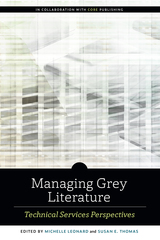 Managing Grey Literature: Technical Services Perspectives
Michelle Leonard
American Library Association, 2021 An important resource for scholarly research, grey literature is relevant to every discipline. It’s also often more current than commercial publications. Unfortunately, though it provides a richness of content, this type of scholarly resource is often overlooked when conducting research. This book aims to change that, describing the importance of grey literature and offering a holistic approach to successfully integrating it into library collections. Readers will learn - an overview of grey literature that discusses its importance to researchers, scholars, and students;
- collections policies for selection and deselection, complete with a suggested workflow;
- information about vendors, OA, and other aspects of acquisitions;
- guidance on cataloging, such as collection categories in the public-facing catalog, and preservation; and
- methods for promoting grey literature in library collections, including institutional repositories; and
- tips for marketing, branding, outreach, and best communication practices for colleagues, administrators, and patrons.
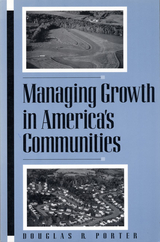 Managing Growth in America's Communities
Douglas R. Porter
Island Press, 1997 Communities across the country are turning to the concept of "growth management" to help plan for the future, as they seek to control the location, impact, character and timing of development in order to balance environmental and economic needs and concerns. Managing Growth in America's Communities presents practical information about proven strategies, programs and techniques of growth management for urban and rural communities. Topics examined include: - public roles in community development
- determining locations and character of future development
- protecting environmental and natural resources
- managing infrastructure development
- preserving community character and quality
- achieving economic and social goals
- property rights concerns
The author describes regulatory and programmatic techniques that have been most useful, obstacles to be overcome, and specific strategies that have been instrumental in achieving successful growth management programs. He provides examples from dozens of communities across the country as well as state and regional approaches currently in use. Brief profiles present overviews of problems addressed, techniques implemented, outcomes, and contact information for conducting further research. Among the communities profiled are Arlington County, Virginia; Fort Collins, Colorado; Lexington-Fayette County, Kentucky; Lincoln, Nebraska; Sarasota, Florida; Raleigh, North Carolina; Scottsdale, Arizona; and numerous others. Also included in the volume are informational sidebars written by leading experts in growth management including Robert Yaro, John De Grove, David Brower, and others. Managing Growth in America's Communities is essential reading for community development specialists including government officials, planners, environmentalists, designers, developers, business people, and concerned citizens seeking innovative and feasible ways to manage growth.
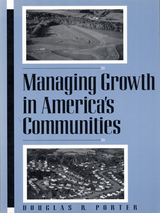 Managing Growth in America's Communities: Second Edition
Douglas Porter
Island Press, 2007 In this thoroughly revised edition of Managing Growth in America’s Communities, readers will learn the principles that guide intelligent planning for communities of any size, grasp the major issues in successfully managing growth, and discover what has actually worked in practice (and where and why). This clearly written book details how American communities have grappled with the challenges of planning for growth and the ways in which they are adapting new ideas about urban design, green building, and conservation. It describes the policies and programs they have implemented, and includes examples from towns and cities throughout the U.S.
Growth management is essential today, as communities seek to control the location, impact, character, and timing of development in order to balance environmental and economic needs and concerns.
The author, who is one of the nation’s leading authorities on managing community growth, provides examples from dozens of communities across the country, as well as state and regional approaches. Brief profiles present overviews of specific problems addressed, techniques utilized, results achieved, and contact information for further research. Informative sidebars offer additional perspectives from experts in growth management, including Robert Lang, Arthur C. Nelson, Erik Meyers, and others.
In particular, he considers issues of population growth, eminent domain, and the importance of design, especially green design. He also reports on the latest ideas in sustainable development, smart growth, neighborhood design, transit-oriented development, and green infrastructure planning. Like its predecessor, the second edition of Managing Growth in America’s Communities is essential reading for anyone who is interested in how communities can grow intelligently.
Managing Internet of Things Applications across Edge and Cloud Data Centres
Rajiv Ranjan
The Institution of Engineering and Technology, 2024 Cloud computing has been a game changer for internet-based applications such as content delivery networks, social networking and multi-tier enterprise applications. However, the requirements for low-latency data access, security, bandwidth, mobility, and cost have challenged centralized data center-based cloud computing models, which is driving the need for the novel computing paradigms of edge and fog computing. The internet of things (IoT) focuses on discovery, aggregation, management, and acting on data originating from internet-connected devices via programmable sensors, actuators, mobile phones, surveillance cameras, routers, gateways and switches. But the aggregation of this data is expensive and can be time consuming.
Managing Land Use Conflicts: Case Studies in Special Area Management
David J. Brower and Daniel S. Carol, eds.
Duke University Press, 1987 This work contains a series of case studies of the planning phenomenon that has become known as Special Area Management (SAM)--those areas so naturally valuable, so important for human use, so sensitive to impact, or so particular in their planning requirements as to need special management treatment. Based on an examination of the SAMs, this work integrates various aspects of the process of their planning and management and proposes policy and administrative guidelines to improve SAMs as a planning tool.
 Managing Legal Uncertainty: Elite Lawyers in the New Deal
Ronen Shamir
Duke University Press, 1995 With the New Deal came a dramatic expansion of the American regulatory state. Threatening to undermine many of the traditional roles of the legal system and its actors by establishing a system of administrative law, the new emphasis on federal legislation as a form of social and economic planning ushered in an era of "legal uncertainty." In this study Ronen Shamir explores how elite corporate lawyers and the American Bar Association clashed with academic legal realists over the constitutionality of the New Deal’s legislative program.
Applying the insights of Weber and Bourdieu to the sociology of the legal profession, Shamir shows that elite members of the bar had a keen self-interest in blocking the expansion of administrative law. He dismisses as oversimplified the view that elite lawyers were "hired guns" who argued that New Deal legislation was unconstitutional solely because of their duty to represent their capitalist clients. Instead, Shamir suggests, their alignment with the capitalist class was an incidental result of their attempt to articulate their vision of the law as scientific, apolitical, and judicially oriented—and thereby to defend their own position within the law profession. The academic legal realists on the other side of the constitutional debates criticized the rigidity of the traditional judicial process and insisted that flexibility of interpretation and the uncertainty of legal outcomes was at the heart of the legal system. The author argues that many legal realists, encouraged by the experimental nature of the New Deal, seized an opportunity to improve on their marginal status within the legal profession by moving their discussions from academic circles to the national policy agenda.
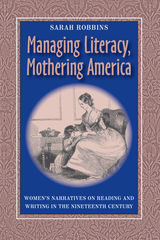 Managing Literacy, Mothering America: Women's Narratives on Reading and Writing in the Nineteenth Century
Sarah Robbins
University of Pittsburgh Press, 2004
Managing Literacy, Mothering America accomplishes two monumental tasks. It identifies and defines a previously unstudied genre, the domestic literacy narrative, and provides a pioneering cultural history of this genre from the early days of the United States through the turn of the twentieth century.
Domestic literacy narratives often feature scenes that depict women-mostly middle-class mothers-teaching those in their care to read, write, and discuss literature, with the goal of promoting civic participation. These narratives characterize literature as a source of shared knowledge and social improvement. Authors of these works, which were circulated in a broad range of publication venues, imagined their readers as contributing to the ongoing formation of an idealized American community.
At the center of the genre's history are authors such as Lydia Sigourney, Catharine Maria Sedgwick, and Frances Harper, who viewed their writing as a form of teaching for the public good. But in her wide-ranging and interdisciplinary investigation, Robbins demonstrates that a long line of women writers created domestic literacy narratives, which proved to be highly responsive to shifts in educational agendas and political issues throughout the nineteenth century and beyond.
Robbins offers close readings of texts ranging from the 1790s to the 1920s. These include influential British precursors to the genre and early twentieth-century narratives by women missionaries that have been previously undervalued by cultural historians. She examines texts by prominent authors that have received little critical attention to date-such as Lydia Maria Child's Good Wives--and provides fresh context when discussing the well-known works of the period. For example, she reads Uncle Tom's Cabin in relation to Harriet Beecher Stowe's education and experience as a teacher.
Managing Literacy, Mothering America is a groundbreaking exploration of nineteenth-century U.S. culture, viewed through the lens of a literary practice that promoted women's public influence on social issues and agendas.
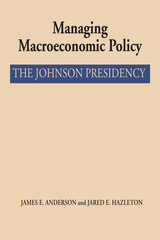 Managing Macroeconomic Policy: The Johnson Presidency
By James E. Anderson and Jared E. Hazleton
University of Texas Press, 1986 Macroeconomic policy involves government action intended to influence the overall operation of the economy and to deal with such important public problems as economic growth, inflation, unemployment, and recession. In this first comprehensive treatment of presidential management of such policy for any presidency, authors James E. Anderson and Jared E. Hazleton focus on four tasks: developing and maintaining an information and decision-making system; coordination of policies in different macroeconomic areas; building support or consent for presidential policies; and administrative leadership. Drawing extensively upon presidential documents and interviews with Johnson administration officials, the authors pay particular attention to fiscal, monetary, wage-price, and international economic (especially balance of payments) policies during Johnson’s terms.
The authors use the concept of the subpresidency, as defined by Redford and Blisset in Organizing the Executive Branch: The Johnson Presidency (University of Chicago Press, 1981), to show how Johnson managed the macro-economic institutions of the council of Economic Advisors, the Bureau of the Budget (now the Office of Management and Budget), the Department of the Treasury, and the Federal Reserve Board in pursuit of his economic goals. What emerges is a vivid portrait of an activist president.
In evaluating management of macroeconomic policy in the Johnson administration, the authors focus on how presidential policies are developed and adopted rather than on the substance of the policies themselves. They conclude that the Johnson administration competently managed policy development during its presidential years.
This book is a volume in the Administrative History of the Johnson Presidency Series sponsored by the LBJ School of Public Affairs at the University of Texas at Austin, the first two volumes of which were published by the University of Chicago Press. Managing Macroeconomic Policy: The Johnson Presidency was funded in part by the National Endowment for the Humanities.
 Managing Madness in the Community: The Challenge of Contemporary Mental Health Care
Kerry Michael Dobransky
Rutgers University Press While mental illness and mental health care are increasingly recognized and accepted in today’s society, awareness of the most severely mentally ill—as well as those who care for them—is still dominated by stereotypes. Managing Madness in the Community dispels the myth. Readers will see how treatment options often depend on the social status, race, and gender of both clients and carers; how ideas in the field of mental health care—conflicting priorities and approaches—actually affect what happens on the ground; and how, amid the competing demands of clients and families, government agencies, bureaucrats and advocates, the fragmented American mental health system really works—or doesn’t.
In the wake of movies like One Flew Over the Cuckoo’s Nest and Shutter Island, most people picture the severely or chronically mentally ill being treated in cold, remote, and forbidding facilities. But the reality is very different. Today the majority of deeply troubled mental patients get treatment in nonprofit community organizations. And it is to two such organizations in the Midwest that this study looks for answers. Drawing upon a wealth of unique evidence—fifteen months of ethnographic observations, 91 interviews with clients and workers, and a range of documents—Managing Madness in the Community lays bare the sometimes disturbing nature and effects of our overly complex and disconnected mental health system.
Kerry Michael Dobransky examines the practical strategies organizations and their clients use to manage the often-conflicting demands of a host of constituencies, laws, and regulations. Bringing to light the challenges confronting patients and staff of the community-based institutions that bear the brunt of caring for the mentally ill, his book provides a useful broad framework that will help researchers and policymakers understand the key forces influencing the mental health services system today.
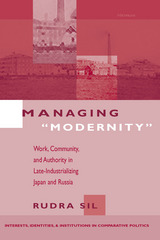 Managing "Modernity": Work, Community, and Authority in Late-Industrializing Japan and Russia
Rudra Sil
University of Michigan Press, 2002 In Managing "Modernity," Rudra Sil examines how institution-builders respond to the competing influences of institutional models and inherited social legacies as they attempt to generate and sustain authority in late-industrializing societies. Through a historical and comparative study of large-scale enterprises in Japan and Russia, the book examines the impact of different institution-building strategies on managerial authority, invoking the experience of postwar Japan to highlight the benefits of a syncretic approach that selectively integrates adaptable features of borrowed institutions with portable norms inherited from preexisting communities.
Managing "Modernity" engages a variety of intellectual perspectives in the social sciences. The theoretical approach represents a conscious effort to overcome the contentious debates in political science and sociology among proponents of historical institutionalism, cultural analysis, and rational-choice theory. The substantive argument draws on, and partially integrates, concepts and findings from comparative politics, economic sociology, industrial relations, organization theory, business management, and the political economy of Japan and Russia.
In light of ongoing debates over the significance and impact of "globalization," the eclectic and integrative approach in Managing "Modernity" offers a fresh and provocative contribution that will interest scholars and graduate students across a variety of disciplines and subfields. It offers compelling insights to anyone generally concerned with the social forces that facilitate or hinder the diffusion of ideas and institutions across national boundaries.
Rudra Sil is Janice and Julian Bers Assistant Professor in the Social Sciences, Department of Political Science, University of Pennsylvania.
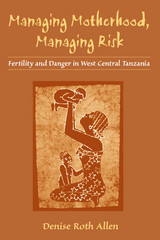 Managing Motherhood, Managing Risk: Fertility and Danger in West Central Tanzania
Denise Roth Allen
University of Michigan Press, 2004 In Managing Motherhood, Managing Risk, Denise Roth Allen persuasively argues that development interventions in the Third World often have unintended and unacknowledged consequences. Based on twenty-two months of fieldwork in the Shinyanga Region of west central Tanzania, this rich and engaging ethnography of women's fertility-related experiences highlights the processes by which a set of seemingly well-intentioned international maternal health policy recommendations go awry when implemented at the local level. An exploration of how threats to maternal health have been defined and addressed at the global, national, and local levels, Managing Motherhood, Managing Risk presents two contrasting, and oftentimes competing, definitions of risk: those that form the basis of international recommendations and national maternal health policies and those that do not. The effect that these contrasting definitions of risk have on women's fertility-related experiences at the local level are explored throughout the book. This study employs an innovative approach to the analysis of maternal health risk, one that situates rural Tanzanian women's fertility-related experiences within a broader historical and sociocultural context. Beginning with an examination of how maternal health risk was defined and addressed during the early years of British colonial rule in Tanganyika and moving to a discussion of an internationally conceived maternal health initiative that was launched on the world stage in the late 1980s, the author explores the similarities in the language used and solutions proposed by health development experts over time. This set of "official" maternal health risks is then compared to an alternative set of risks that emerge when attention is focused on women's experiences of pregnancy and childbirth at the local level. Although some of these latter risks are often spoken about as deriving from spiritual or supernatural causes, the case studies presented throughout the second half of the book reveal that the concept of risk in the context of pregnancy and childbirth is much more complex, involving the interplay of spiritual, physical, and economic aspects of everyday life.
Managing National Security Policy: The President and the Process
William W. Newmann
University of Pittsburgh Press, 2003 William Newmann examines the ways in which presidents make national security decisions, and explores how those processes evolve over time. He creates a complex portrait of policy making, which may help future presidents design national security decision structures that fit the realities of the office in today's world.
 Managing Readers: Printed Marginalia in English Renaissance Books
William W. E. Slights
University of Michigan Press, 2001 Managing Readers explores the fascinating interchange between text and margin, authorship and readership in early modern England. Printed marginalia did more than any other material feature of book production in the period between 1540 and 1700 to shape the experience of reading. William W. E. Slights considers overlooked evidence of the ways that early modern readers were instructed to process information, to contest opinions, and to make themselves into fully responsive consumers of texts.
The recent revolution in the protocols of reading brought on by computer technology has forced questions about the nature of book-based knowledge in our global culture. Managing Readers traces changes in the protocols of annotation and directed reading--from medieval religious manuscripts and Renaissance handbooks for explorers, rhetoricians, and politicians to the elegant clear-text editions of the Enlightenment and the hypertexts of our own time. Developing such concepts as textual authority, generic difference, and reader-response, Slights demonstrates that printed marginalia were used to confirm the authority of the text and to undermine it, to supplement "dark" passages, and to colonize strategic hermeneutic spaces. The book contains twenty-two illustrations of pages from rare-book archives that make immediately clear how distinctive the management of the reading experience was during the first century-and-a-half of printing in England.
William W. E. Slights is Professor of English, University of Saskatchewan. He is also author of Ben Jonson and the Art of Secrecy.
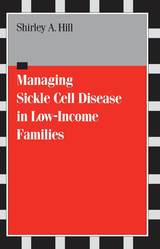 Managing Sickle Cell Disease: In Low-Income Families
Shirley A. Hill
Temple University Press, 2003 As many as 30,000 African Americans have sickle cell disease (SCD). Though the political activism of the 1960s and a major 1970s health campaign spurred demands for testing, treatment, and education programs, little attention has been given to how families cope with SCD. This first study to give SCD a social, economic, and cultural context documents the daily lives of families living with this threatening illness. Specifically, Shirley A. Hill examines how low-income African American mothers with children suffering from this hereditary, incurable, and chronically painful disease, react to the diagnosis and manage their family's health care.The 23 mostly single mothers Hill studies survive in an inner-city world of social inequality. Despite limited means, they actively participate, create, and define the social world they live in, their reality shaped by day-to-day caregiving. These women overcome obstacles by utilizing such viable alternatives as sharing child care with relatives within established kinship networks.Highlighting the role of class, race, and gender in the illness experience, Hill interprets how these women reject, redefine, or modify the objective scientific facts about SCD. She acknowledges and explains the relevance of child-bearing and motherhood to African American women's identity, revealing how the revelation of the SCD trait or the diagnosis of one child often does not affect a woman's interpretation of her reproductive rights.
 Managing the Climate Crisis: Designing and Building for Floods, Heat, Drought, and Wildfire
Jonathan Barnett and Matthijs Bouw
Island Press, 2022 The climate, which had been relatively stable for centuries, is well into a new and dangerous phase. In 2020 there were 22 weather and climate disasters in the United States, which resulted in 262 deaths. Each disaster cost more than a billion dollars to repair. This dangerous trend is continuing with unprecedented heat waves, extended drought, extraordinary wildfire seasons, torrential downpours, and increased coastal and river flooding. Reducing the causes of the changing climate is the urgent global priority, but the country will be living with worsening climate disasters at least until midcentury because of greenhouse emissions already in the atmosphere. How to deal with the changing climate is an urgent national security problem affecting almost everyone.
In Managing the Climate Crisis, design and planning experts Jonathan Barnett and Matthijs Bouw take a practical approach to addressing the inevitable and growing threats from the climate crisis using constructed and nature-based design and engineering and ordinary government programs. They discuss adaptation and preventive measures and illustrate their implementation for seven climate-related threats: flooding along coastlines, river flooding, flash floods from extreme rain events, drought, wildfire, long periods of high heat, and food shortages.
The policies and investments needed to protect lives and property are affordable if they begin now, and are planned and budgeted over the next 30 years. Preventive actions can also be a tremendous opportunity, not only to create jobs, but also to remake cities and landscapes to be better for everyone. Flood defenses can be incorporated into new waterfront parks. The green designs needed to control flash floods can also help shield communities from excessive heat. Combating wildfires can produce healthier forests and generate creative designs for low-ignition landscapes and more fire-resistant buildings. Capturing rainwater can make cities respond to severe weather more naturally, while conserving farmland from erosion and encouraging roof-top greenhouses can safeguard food supplies.
Managing the Climate Crisis is a practical guide to managing the immediate threats from a changing climate while improving the way we live.
Managing the Counterrevolution: The United States and Guatemala, 1954–1961
Stephen M. Streeter
Ohio University Press, 2001 The Eisenhower administration’s intervention in Guatemala is one of the most closely studied covert operations in the history of the Cold War. Yet we know far more about the 1954 coup itself than its aftermath. This book uses the concept of “counterrevolution” to trace the Eisenhower administration’s efforts to restore U.S. hegemony in a nation whose reform governments had antagonized U.S. economic interests and the local elite. Comparing the Guatemalan case to U.S.-sponsored counterrevolutions in Iran, the Dominican Republic, Brazil, and Chile reveals that Washington’s efforts to roll back “communism” in Latin America and elsewhere during the Cold War represented in reality a short-term strategy to protect core American interests from the rising tide of Third World nationalism.
 Managing the Environmental Crisis: Incorporating Competing Values in Natural Resource Administration
William R. Mangun and Daniel H. Henning
Duke University Press, 1999 Second edition With a new foreword by Lynton Keith Caldwell In Managing the Environmental Crisis William R. Mangun and Daniel H. Henning provide a balanced and comprehensive guide to the management of complex environmental and natural resource policy issues. Taking into account new developments, trends, and issues that have arisen in recent years, the authors begin with the recognition, often overlooked, that it is not the environment that needs to be managed but human action relating to the environment.
The authors review issues associated with a range of environmental policy concerns, including energy considerations, renewable and non renewable resource management, pollution control, wilderness management, and urban and regional policy. The history of these issues, recent actions pertaining to their management, difficulties associated with their continued presence, and the consequences of a failure to address these concerns are explored. Though focused on specific political issues, Mangun and Henning direct their attention to two large-scale trends—globalization and the political polarization of the environmental movement. At the level of the decision-making process, the incorporation of values—specifically addressed from multicultural and cross-disciplinary perspectives—is also discussed. International in scope, the book provides descriptions of the roles of both governmental and nongovernmental organizations in the formulations and implementation of national and global environmental policy.
This thoroughly revised second edition discusses various successes in the arenas of environmental cooperation and management strategy while pointing to the new challenges that have emerged in the last decade.
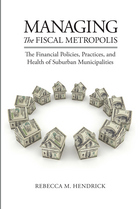 Managing the Fiscal Metropolis: The Financial Policies, Practices, and Health of Suburban Municipalities
Rebecca M. Hendrick
Georgetown University Press, 2013 Managing the Fiscal Metropolis: The Financial Policies, Practices, and Health of Suburban Municipalities is an important book. This first comprehensive analysis of the financial condition, management, and policy making of local governments in a metropolitan region offers local governments currently dealing with the Great Recession a better understanding of what affects them financially and how to operate with less revenue. Hendrick’s groundbreaking study covers 264 Chicago suburban municipalities from the late 1990s to the present. In it she identifies and describes the primary factors and events that affect municipal financial decisions and financial conditions, explores the strategies these governments use to manage financial conditions and solve financial problems, and looks at the impact of contextual factors and stresses on government financial decisions. Managing the Fiscal Metropolis offers new evidence about the role of contextual factors— including other local governments—in the financial condition of municipalities and how municipal financial decisions and practices alter these effects. The wide economic and social diversity of the municipalities studied make its findings relevant on a national scale.
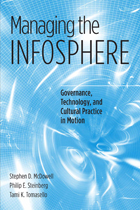 Managing the Infosphere: Governance, Technology, and Cultural Practice in Motion
Stephen D. McDowell, Philip E. Steinberg and Tami K. Tomasello
Temple University Press, 2007 Managing the Infosphere examines the global world of communications as a mobile space that overlaps uneasily with the world of sovereign, territorial nation-states. Drawing on their expertise in geography, political science, international relations, and communication studies, the authors investigate specific policy problems encountered when international organizations, corporations, and individual users try to "manage" a space that simultaneously contradicts and supports existing institutions and systems of governance, identity, and technology.
The authors argue that the roles of these systems in cyberspace cannot be fully understood unless they are seen as mutually constituting each other in specific historical structures, institutions, and practices. With vision and insight, the authors look beyond the Internet to examine the entire networked world, from cell phones and satellites to global tourism and business travel.
Managing the Internet of Things: Architectures, theories and applications
Jun Huang
The Institution of Engineering and Technology, 2017 The Internet of Things (IoT) refers to the evolution of the internet as the interconnection not just of computers, but also uniquely identifiable, pervasive embedded devices. Research has estimated there will be nearly 30 billion devices on the Internet of Things within the next decade. The implementation and deployment of the IoT brings with it management challenges around seamless integration, heterogeneity, scalability, mobility, security, and many other issues. This book explores these challenges and possible solutions.
 Managing the Magic of Old Places: Crafting Public Policies for Human-Centered Historic Preservation
Jeremy Wells
University of Tennessee Press, 2025 From 1849 to the early 1980s, the development of US historic preservation policy was shaped by fewer than one hundred elite White men from Europe and America. This orthodox preservation doctrine has too long silenced the vibrant, experiential relationships between everyday people and their heritage. Managing the Magic of Old Places: Crafting Public Policies for Human-Centered Historic Preservation offers a radical rethinking of how historic preservation is approached in the United States.
Author Jeremy C. Wells argues for a revolutionary shift in federal preservation policy—one that embraces community-based participatory practice and draws from environmental psychology to tap into the intangible, emotional connections people have with old places. Wells highlights the experiential values that laypeople often ascribe to historic environments, which are frequently dismissed by expert-driven policies. He contends that if historic preservation policy continues to ignore these aspects, the field will lose relevance as the gap between professionals and the public widens. Drawing from interdisciplinary research in the social sciences, particularly phenomenology and environmental psychology, Wells’s vision of public preservation policy centers the lived experiences of communities, reinvigorating the field and ensuring that the preservation of historic places resonates with a wider, more inclusive audience.
Wells positions his work within the growing field of critical heritage studies, yet his focus on the psychological and emotional aspects of preservation distinguishes it as a unique contribution. By placing the needs and experiences of the public at the heart of preservation efforts, Wells critiques the historical foundations of US preservation policy while offering a bold agenda for reform.
Managing the Presidency: Carter, Reagan, and the Search for Executive Harmony
Colin Campbell
University of Pittsburgh Press, 1988
Arguing that too many studies focus on president's personalities, and not their relationships with advisers and the machinery of the office, Campbell describes the institutional development of the presidency and assesses the Carter and Regan administrations within a historical context. Interviews with senior members of the White House staff and other high-ranking officials add color and depth to his study.
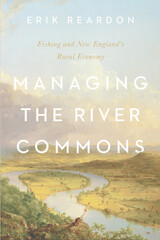 Managing the River Commons: Fishing and New England's Rural Economy
Erik Reardon
University of Massachusetts Press, 2021 New England once hosted large numbers of anadromous fish, which migrate between rivers and the sea. Salmon, shad, and alewives served a variety of functions within the region's preindustrial landscape, furnishing not only maritime areas but also agricultural communities with an important source of nutrition and a valued article of rural exchange.
Historian Erik Reardon argues that to protect these fish, New England's farmer-fishermen pushed for conservation measures to limit commercial fishing and industrial uses of the river. Beginning in the colonial period and continuing to the mid-nineteenth century, they advocated for fishing regulations to promote sustainable returns, compelled local millers to open their dams during seasonal fish runs, and defeated corporate proposals to erect large-scale dams. As environmentalists work to restore rivers in New England and beyond in the present day, Managing the River Commons offers important lessons about historical conservation efforts that can help guide current campaigns to remove dams and allow anadromous fish to reclaim these waters.
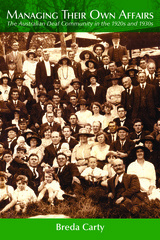 Managing Their Own Affairs: The Australian Deaf Community in the 1920s and 1930s
Breda Carty
Gallaudet University Press, 2017 Managing Their Own Affairs explores how Deaf organizations and institutions were forged in Australia during the early 20th century. During this period, deaf people challenged the authority of the dominant welfare organizations, or Deaf Societies, which were largely controlled by hearing people and run as charitable institutions. Breda Carty comprehensively documents the growth of the Australian Deaf community and Australian Deaf organizations for the first time. She focuses on both the political developments of the early 20th century and on the nature of the relationships between deaf and hearing people.
During this time, deaf Australians aspired to manage their own affairs. They enjoyed some success by establishing “breakaways” from the Deaf Societies, and they also established an independent national organization, which was contested and ultimately suppressed by the Deaf Societies. These developments were influenced by wider social movements in Australian society, such as the mobilization of minority groups in their push for autonomy and equal rights. Although most of the breakaway Deaf organizations did not survive beyond the 1930s, they significantly affected the power structures and relationships between deaf and hearing people in Australia. The Australian Deaf community’s attempts to organize independently during these years have been largely erased from collective memory, making Carty’s examination a particularly important and necessary addition to the historical literature.
 Managing to Make It: Urban Families and Adolescent Success
Frank F. Furstenberg, Thomas D. Cook, Jacquelynne Eccles, Glen H. Elder Jr.,
University of Chicago Press, 1999 One of the myths about families in inner-city neighborhoods is that they are characterized by poor parenting. Sociologist Frank Furstenberg and his colleagues explode this and other misconceptions about success, parenting, and socioeconomic advantage in Managing to Make It. This unique study—the first in the MacArthur Foundation Studies on Successful Adolescent Development series—focuses on how and why youth are able to overcome social disadvantages.
Based on nearly 500 interviews and case studies of families in inner-city Philadelphia, Managing to Make It lays out in detail the creative means parents use to manage risks and opportunities in their communities. More importantly, it also depicts the strategies parents develop to steer their children away from risk and toward resources that foster positive development and lead to success.
"Indispensible to anyone concerned about breaking the cycle of poverty and helplessness among at-risk adolescents, this book has a readable, graphic style easily grasped by those unfamiliar with statistical techniques." —Library Journal
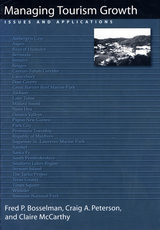 Managing Tourism Growth: Issues And Applications
Fred P. Bosselman, Craig Peterson, and Claire McCarthy
Island Press, 1999 Tourism is by many measures the world's largest and fastest growing industry, and it provides myriad benefits to hosts and visitors alike. Yet if poorly managed, tourism can have serious negative impacts on tourist communities-their environment, physical appearance, economy, health, safety, and even their social values. Managing Tourism Growth analyzes and evaluates methods by which communities can carefully control tourism in order to maximize the positive aspects while minimizing the detrimental effects. The authors offer vivid examples of the ways in which uncontrolled tourism can adversely affect a community, and explain how to create an effective strategy that can protect tourism resources for current and future generations. Specific chapters provide detailed descriptions and evaluations of various approaches that communities around the world have successfully used. The authors examine alternative legal and regulatory measures, management techniques, and incentives that target tourism growth at all levels, from the quality of development, to its amount and rate of growth, to the locations in which it takes place. Approaches examined include: quality differentiation, performance standards, and trade-off strategies; preservation rules, growth limitations, and incremental growth strategies; expansion, dispersal, and concentration strategies, and identification of new tourism resources. The final chapter presents a concise and useful checklist of the elements of successful strategies that can help guide destination communities in the planning process. An outstanding feature of the book is the numerous and varied case studies it offers, including Santa Fe, New Mexico; Milford Sound, New Zealand; Nusa Dua, Bali; Great Barrier Reef, Australia; Sanibel, Florida; Canterbury, England; Republic of Maldives; Bruges, Belgium; Times Square, New York; Papua New Guinea; Park City, Utah; Whistler, British Columbia; and many others. The depth and accessibility of information provided, along with the wealth of global case studies, make the book must-reading for planning professionals, government officials, tourism industry executives, consultants, and faculty and students of geography, planning, or tourism.
Managing Turbulent Hearts: A Balinese Formula for Living
Unni Wikan
University of Chicago Press, 1990 How do Balinese manage to present to the world the clear, bright face, the grace and poise, that they regard as crucial to self-respect and social esteem? How can the anthropologist pass behind the conventions of such a complex culture to recognize what is going on between people, in terms that convey their own experience?
Wikan's study of the Indonesian island of Bali is an absorbing debate with previous anthropological interpretations as well as an innovative development of the anthropology of experience.
"This is indeed an important book, a landmark in studies of Bali and one surely destined to have major theoretical impact on anthropological research well beyond that famous Indonesian island."—Anthony R. Walker, Journal of Asian and African Studies
 Managing within Networks: Adding Value to Public Organizations
Robert Agranoff
Georgetown University Press, 2007 The real work of many governments is done not in stately domed capitols but by a network of federal and state officials working with local governments and nongovernmental organizations to address issues that cross governmental boundaries. Managing within Networks analyzes the structure, operations, and achievements of these public management networks that are trying to solve intractable problems at the field level. It examines such areas as transportation, economic and rural development, communications systems and data management, water conservation, wastewater management, watershed conservation, and services for persons with developmental disabilities. Robert Agranoff draws a number of innovative conclusions about what these networks do and how they do it from data compiled on fourteen public management networks in Indiana, Iowa, Kentucky, Nebraska, and Ohio. Agranoff identifies four different types of networks based on their purposes and observes the differences between network management and traditional management structures and leadership. He notes how knowledge is managed and value added within intergovernmental networks. This volume is useful for students, scholars, and practitioners of public management.
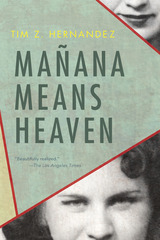 Mañana Means Heaven
Tim Z. Hernandez
University of Arizona Press, 2013 In this love story of impossible odds, award-winning writer Tim Z. Hernandez weaves a rich and visionary portrait of Bea Franco, the real woman behind famed American author Jack Kerouac’s “The Mexican Girl.” Set against an ominous backdrop of California in the 1940s, deep in the agricultural heartland of the Great Central Valley, Mañana Means Heaven reveals the desperate circumstances that lead a married woman to an illicit affair with an aspiring young writer traveling across the United States.
When they meet, Franco is a migrant farmworker with two children and a failing marriage, living with poverty, violence, and the looming threat of deportation, while the “college boy” yearns to one day make a name for himself in the writing world. The significance of their romance poses vastly different possibilities and consequences.
Mañana Means Heaven deftly combines fact and fiction to pull back the veil on one of literature’s most mysterious and evocative characters. Inspired by Franco’s love letters to Kerouac and Hernandez’s interviews with Franco, now in her nineties and living in relative obscurity, the novel brings this lost gem of a story out of the shadows and into the spotlight.
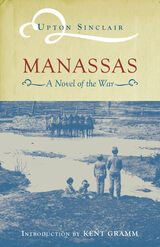 Manassas: A Novel of the War
Upton Sinclair
University of Alabama Press, 2000 Centers on the moral dimension of the conflict as it traces a young Mississippi boy’s conversion from pro-slavery Southerner to abolitionist Union soldier
Allan Montague, born on a Mississippi plantation about twenty years before the Civil War, has grown up with slavery and considers it natural. When his father moves to Boston for business and takes the boy with him, young Allan carries a knife given to him by his cousin to use in killing abolitionists.
The first abolitionist young Allan meets in Boston is Levi Coffin, the reputed founder of the Underground Railroad. In this first of many meetings with historical figures, Allan forms a friendship with Coffin, who eventually takes him to hear a speech by former slave Frederick Douglass. Douglass's powerful words cement Allan's transformation into an abolitionist—a transformation that will lead him back to his Deep South home with the hope of freeing slaves and eventually back to the North and the fateful Battle of Manassas.
Kent Gramm, author of the introduction for this new edition of Manassas, calls the novel “a modern version of the morality play,” with the United States as the central character. “The real story, he writes, is the moral phenomenon of the Civil War.” It is a powerful book that deserves to be revived, read, and studied.
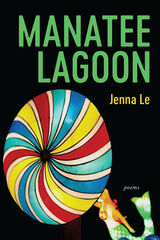 Manatee Lagoon: Poems
Jenna Le
Acre Books, 2022 The third full-length collection from physician and poet Jenna Le blends traditional form and the current moment.
In Manatee Lagoon, sonnets, ghazals, pantoums, villanelles, and a “failed georgic” weave in contemporary subject matter, including social-media comment threads, Pap smears, eclipse glasses, and gun violence. A recurring motif throughout the collection, manatees become a symbol with meanings as wide-ranging as the book itself. Le aligns the genial but vulnerable sea cow with mermaids, neurologists, the month of November, harmful political speech, and even a family photo at the titular lagoon.
In these poems, Le also reflects on the experience of being the daughter of Vietnamese refugees in today’s sometimes tense and hostile America. The morning after the 2016 election, as three women of color wait for the bus, one says, “In this new world, we must protect each other.”
Manatee Lagoon is a treasury of voices, bringing together the personal and the persona, with poems dedicated to Kate Spade, John Ashbery, and Uruguayan poet Delmira Agustini. With this book, Le establishes herself as a talented transcriber of the human condition—and as one of the finest writers of formal verse today.
 The Manchu Mirrors and the Knowledge of Plants and Animals in High Qing China
He Bian and Mårten Söderblom Saarela
Harvard University Press, 2025 As the territory of Qing China expanded, so evolved the ways in which birds, beasts, fish, trees, and flowers came to be known in the multilingual empire. The Manchu Mirrors and the Knowledge of Plants and Animals in High Qing China is the first systematic study of how the Qing court sought to codify Manchu and Chinese words for animals and plants throughout the eighteenth century, with a particular focus on Manchurian and other Inner Asian species. Calling for renewed attention to Manchu dictionaries as an important source for Qing intellectual and cultural history, Bian and Söderblom Saarela show how Qing lexicographical practices embodied major revisions to the Chinese encyclopedic tradition, realigned the relationship between words and things, and left a lasting impact on natural historical scholarship in the modern era. The updated form of Chinese learning, along with the malleable lexicon of the Manchu language, proved useful for the Manchu elite in displaying the reach and intellectual depth of Qing imperial power. Manchu was transformed from the language of a single people into the lexicographic façade for an imperial order of things.
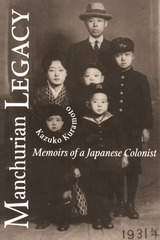 Manchurian Legacy: Memoirs of a Japanese Colonist
Kazuko Kuramoto
Michigan State University Press, 1999 Kazuko Kuramoto was born and raised in Dairen, Manchuria, in 1927, at the peak of Japanese expansionism in Asia. Dairen and the neighboring Port Arthur were important colonial outposts on the Liaotung Peninsula; the train lines established by Russia and taken over by the Japanese, ended there. When Kuramoto's grandfather arrived in Dairen as a member of the Japanese police force shortly after the end of the Russo-Japanese War in 1905, the family's belief in Japanese supremacy and its "divine" mission to "save" Asia from Western imperialists was firmly in place. As a third-generation colonist, the seventeen-year-old Kuramoto readily joined the Red Cross Nurse Corps in 1944 to aid in the war effort and in her country's sacred cause. A year later, her family listened to the emperor's radio broadcast ". . . we shall have to endure the unendurable, to suffer the insufferable." Japan surrendered unconditionally.
Manchurian Legacy is the story of the family's life in Dairen, their survival as a forgotten people during the battle to reclaim Manchuria waged by Russia, Nationalist China, and Communist China, and their subsequent repatriation to a devastated Japan. Kuramoto describes a culture based on the unthinking oppression of the colonized by the colonizer. And, because Manchuria was, in essence, a Japanese frontier, her family lived a freer and more luxurious life than they would have in Japan—one relatively unscathed by the war until after the surrender.
As a commentator Kuramoto explores her culture both from the inside, subjectively, and from the outside, objectively. Her memoirs describe her coming of age in a colonial society, her family's experiences in war-torn Manchuria, and her "homecoming" to Japan—where she had never been—just as Japan is engaged in its own cultural upheaval.
The Mandarin and the Cadre: China’s Political Cultures
Lucian W. Pye
University of Michigan Press, 2000 Combining political psychology with his own insights into Chinese culture, Pye addresses perplexing but profoundly important questions about Chinese political behavior and makes fundamental contributions both to our understanding of the political culture of China and to the theory of political culture itself.
A Mandarin and the Making of Public Policy: Reflections
Tong Dow Ngiam
National University of Singapore Press, 2001 Singapore's success story has increasingly been recognised but few have told it from the perspective of an insider. As a senior civil servant and "mandarin" from 1959 to 1999, Ngiam Tong Dow served with the founding generation of political leaders and contributed to the country's economic growth. In this book, he reflects on these experiences, sharing personal anecdotes and perceptive insights of Singapore's early decades. He also boldly questions some of the policies of government and emerging trends in the country to suggest how Singapore must change to survive and thrive in the future.
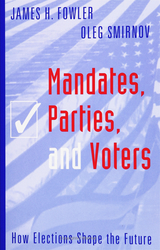 Mandates, Parties, and Voters: How Elections Shape the Future
James H Fowler and Oleg Smirnov
Temple University Press, 2007 Most research on two-party elections has considered the outcome as a single, dichotomous event: either one or the other party wins. In this groundbreaking book, James Fowler and Oleg Smirnov investigate not just who wins, but by how much, and they marshal compelling evidence that mandates-in the form of margin of victory-matter. Using theoretical models, computer simulation, carefully designed experiments, and empirical data, the authors show that after an election the policy positions of both parties move in the direction preferred by the winning party-and they move even more if the victory is large. In addition, Fowler and Smirnov not only show that the divergence between the policy positions of the parties is greatest when the previous election was close, but also that policy positions are further influenced by electoral volatility and ideological polarization. This pioneering book will be of particular interest to political scientists, game theoreticians, and other scholars who study voting behavior and its short-term and long-range effects on public policy.
|
|


